SPA & FRWC Trip to Chad on July 9-26, 2018
Gavin Livingston’s Travel Journal
In July, I had the incredible opportunity to travel to the Republic of Chad with Adam Eyres, the Director of Animal Care at Fossil Rim Wildlife Center and Antelope Conservation Fellow at White Oak, as well as Dr. Julie Swenson, Associate Veterinarian at Fossil Rim.
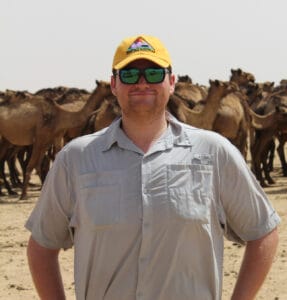
As for me, Gavin Livingston, I am the Manager of the Source Population Alliance (SPA), which is based at Fossil Rim. SPA is an ungulate conservation program and is a part of the Conservation Centers for Species Survival (C2S2), of which Fossil Rim Wildlife Center is a founding member.
Similar to many international trips, just getting to our destination was a journey in itself, and this trip provided plenty of color along the way. Follow along as we navigate delayed flights, airline changes, lost luggage, and a cross-Chadian road trip all on our way to begin the conservation work we traveled 7,200 miles to do.
In Chad, we worked on the scimitar-horned oryx reintroduction project of the Environment Agency – Abu Dhabi (EAD) and Sahara Conservation Fund (SCF). Our mission on this trip was to fit GPS tracking collars on the next group of oryx slated for release back into their native range.
Prior to this project’s beginning in 2016, the scimitar-horned oryx had been extinct in the wild for three decades. Now, with the support of the EAD, the hard work of SCF, and the dedication of breeding centers around the world, the oryx once again roams the desert of Chad.
Monday, 7/9/18, Day 1: The Journey To Chad Begins
Adam, Julie and I left Glen Rose to start our journey to N’Djamena, Chad at around noon. Before we left town though, Adam and I spent the better part of an hour searching for the UPS truck in town to pick up a package that we needed for the trip. We chased down two different UPS trucks, and after a lot of effort and some dumb luck, we were able to get our hands on the hoof trimmers we needed to take to Ric and Justin, the Americans who run the EAD’s oryx project.
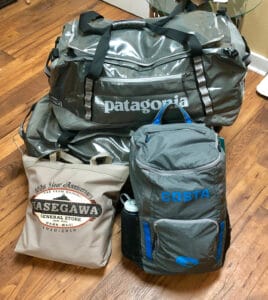
We encountered our second issue of the day during check-in at DFW Airport. Delta would not recognize Adam’s booking credit card to verify my ticket. Fortunately, after trying several different cards, we got it squared away, and we were off on our journey, sort of.
After we checked in, Adam went to go take his truck to long-term parking, and Julie and I went through security to go make our first currency exchange of USD to Euros. We each exchanged $400 USD and got $290 euros back.
While Julie and I were in line at the currency office, Julie checked her email and saw that we all had a message from SCF CEO John Newby. His email said that the GPS collars for the scimitar-horned oryx had not yet arrived in Chad and likely would not be there until the 19th of July, which is the day we were scheduled to depart Chad.
John said that his team has planned to stay until July 24 to ensure the collaring is completed. Since we are already en route, and tickets paid for, we will just assess where we stand in relation to timing once we get to Chad and talk about it more in-depth with John.
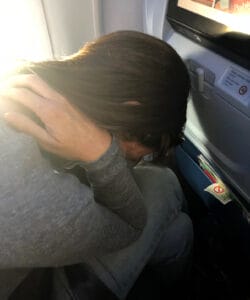
Our Delta flight from DFW then gave us our next curveball by being delayed long enough that we would have missed our connecting flight in Atlanta for Paris. Luckily, Adam was able to talk to the gate agent and we were transferred onto an American Airlines flight that would get us to Atlanta in time to make our connection. On the Atlanta-to-Paris leg of the flight, Adam and I booked exit row seats and scored some great legroom, while Julie got a window seat in another area of the plane – her favorite spot.
Tuesday, 7/10/18, Day 2: Delay Is The Word Of The Day
Once we got to the airport in Paris, it didn’t take long for me to make a spectacle of myself. I went to the restroom to wash my face and brush my teeth; it was only after the fact that I discovered there were not any towels to dry my face.
My next move was obviously not wise, but I did it anyway. I for some reason thought it was a good idea to try and dry my face under the hand dryer; it was not.
I hit my head and almost blew my contact lenses out of my eyes. Hmm… On the plus side, we found RoxAnna, who is joining us on the trip from the Living Desert Zoo in Palm Springs, California. She is the Association of Zoos & Aquariums’ Scimitar-Horned Oryx Species Survival Plan coordinator.
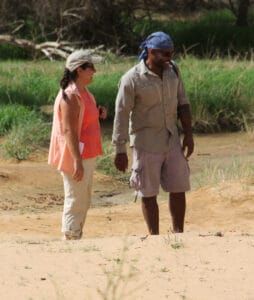
The relative ease of travel on this leg of the trip did not last long; at the last minute, it was announced that we had a gate and terminal change for our flight, which requires going through security again. As we were getting ready to go change gates, we ran into some Environment Agency – Abu Dhabi folks that will be joining us in Chad; Ric, Justin, Lahaj, and Siyeed met us at the gate. We made it through security with a moderate level of hassling and got in line for our Air France flight that was scheduled to leave for N’djamena at 4 p.m.
No sooner do we get in line, than they announce that we have a 1.5-hour delay. After it was all said and done, we ended up with three different gates, three planes and two terminal changes, then we were finally boarded on a plane that just came in from Taiwan at around 8:30 p.m. The flight finally took off at 8:45 p.m. Paris time.
During the plane changes, Adam and I lost our exit row seats we paid for, but the new plane was larger, so we each got our own row on the plane, which worked out pretty well legroom-wise. One item of concern is our luggage. None of the three airlines we have flown on seem to be exactly sure where the bags are, and if they will make it to Chad when we do. I do not have a great feeling about this.
Wednesday, 7/11/18, Day 3: Mr. Livingston, Please Come With Me
We finally landed in Chad around 1 a.m. local time. A shuttle bus took us to the terminal to go through passport control and customs. While going through customs was uneventful, our luggage never made it to Chad. After waiting for all the luggage to come out, we went to the baggage office to file a claim.
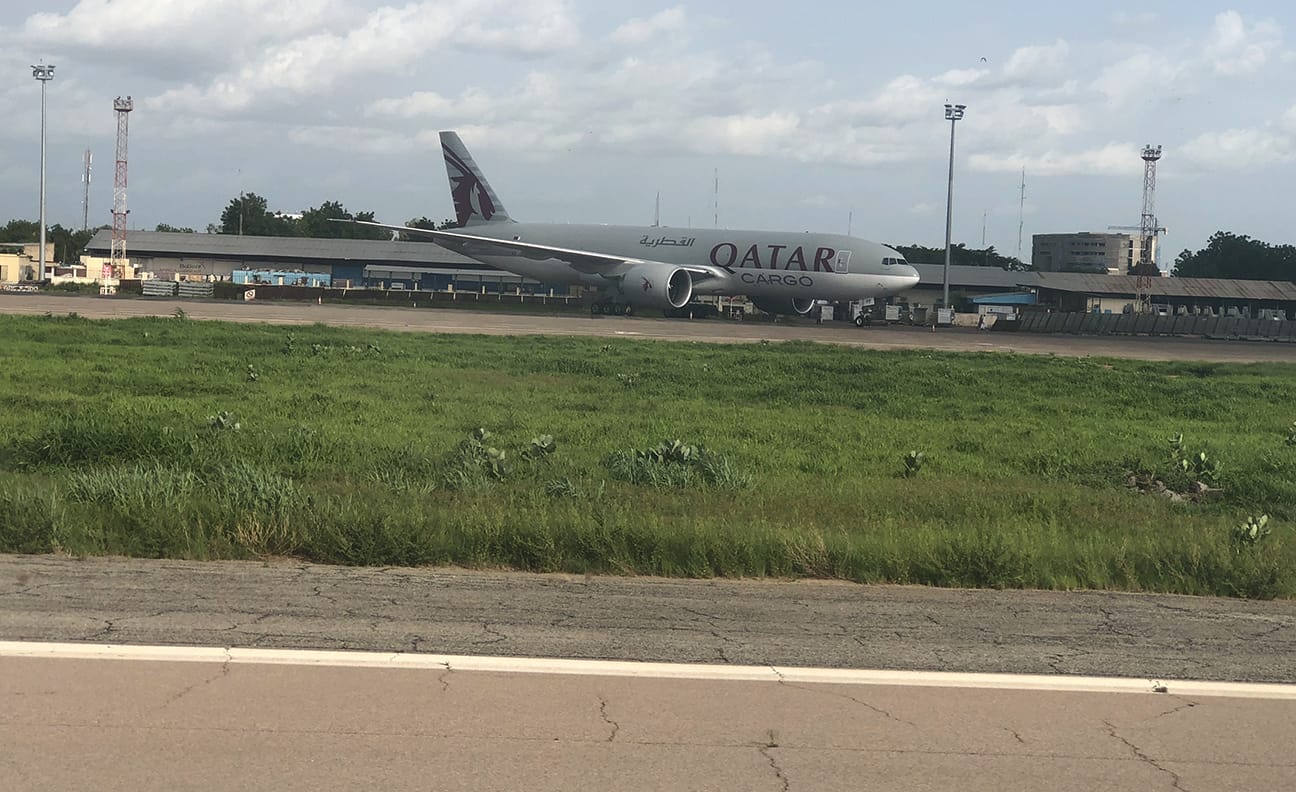
Before we could walk in though, a man who worked at the airport asked me if I was Mr. Livingston. I said I was, and he asked me to please come with him. Now, obviously this made me a bit nervous. Julie and Adam went into this guy’s office with me, and I sat down to talk to him.
Luckily, this was indeed the baggage office. We filled out lost luggage forms and were told the bags would be on the next flight in two days.
By the time Adam, Julie, and I were finished in the baggage office, the rest of the team was already waiting in a Hilton shuttle van. On the way to the hotel, we drove down embassy row, passing dozens of armed guards.
The Hilton N’Djamena is very nice and was only constructed last year. Once you go through the front gate, there are zigzag barricades that must be driven through to get to the unloading area for the lobby.

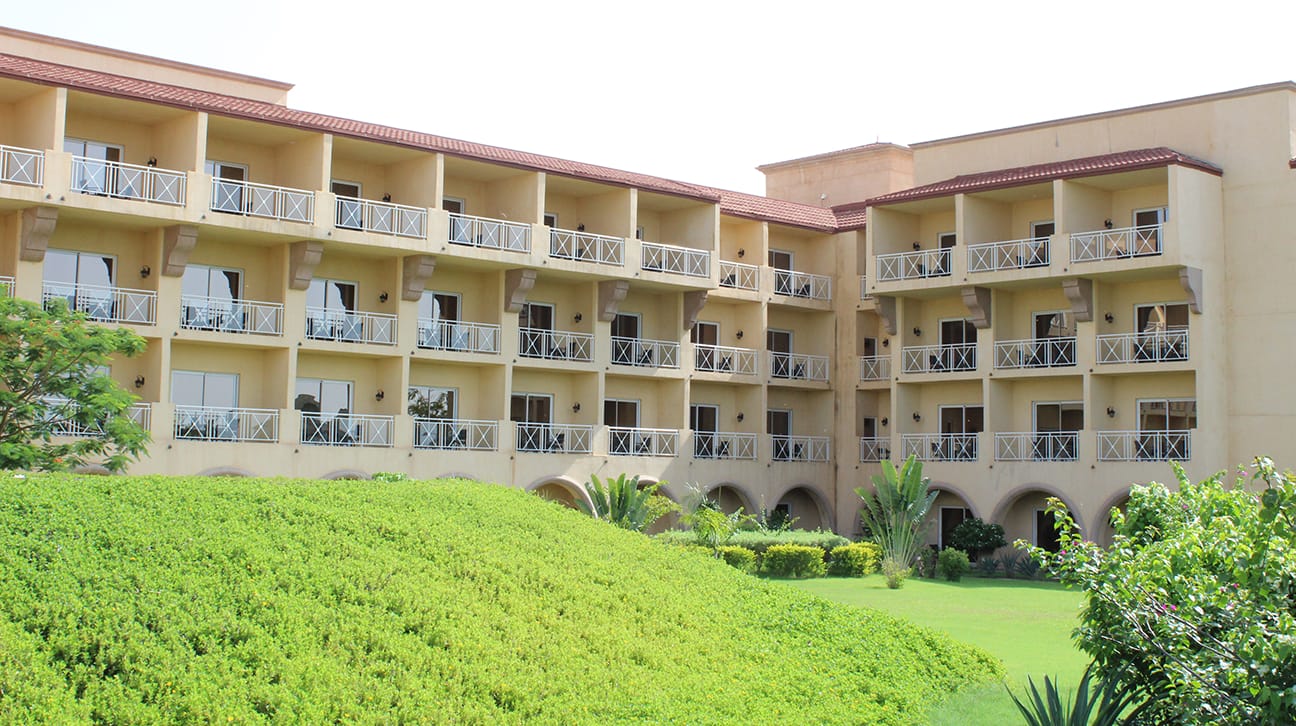
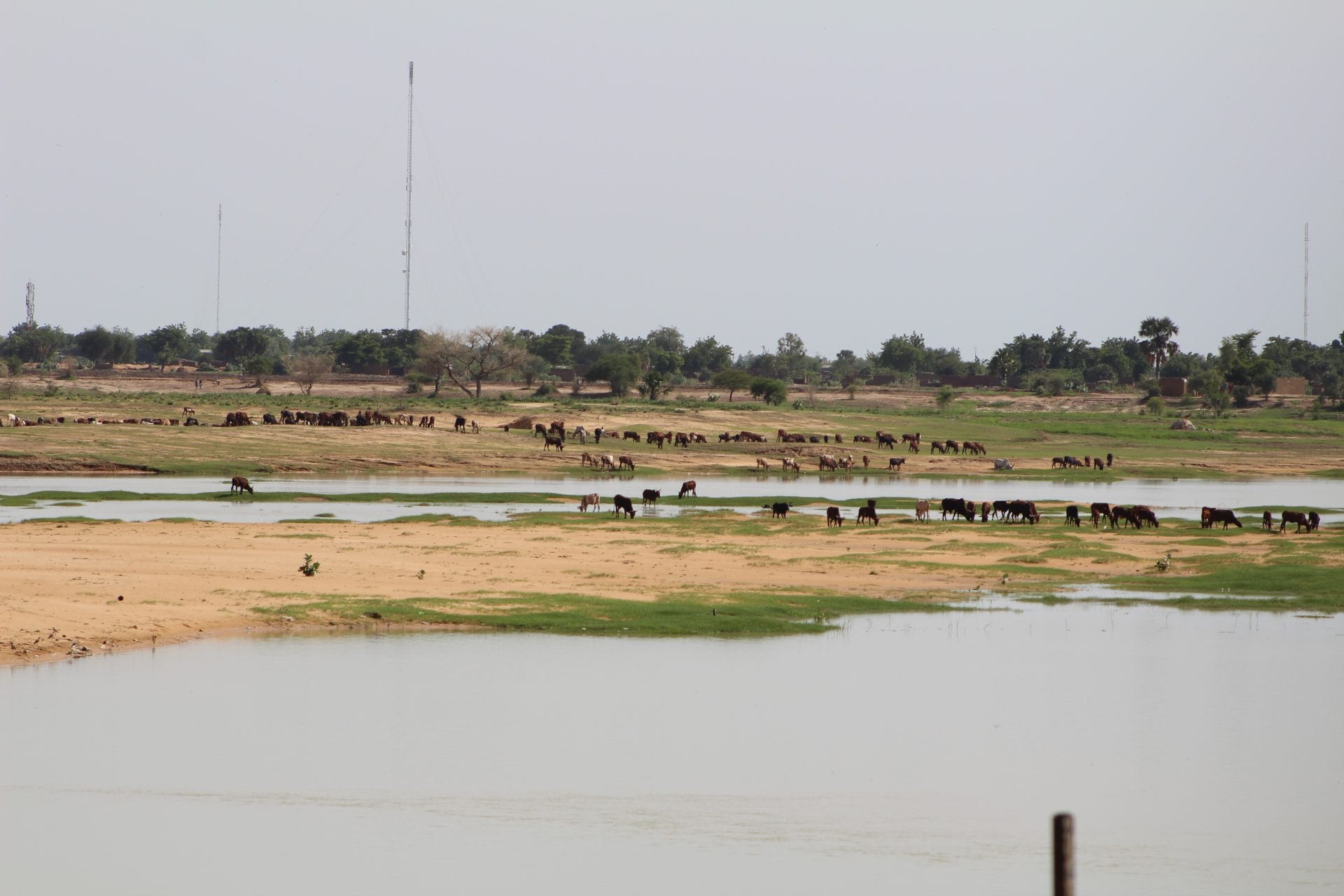
John Newby met us in the hotel lobby and said we should be back down at 6:30 a.m., or three hours from now. We quickly decided that Adam, Julie, and I would be staying at the hotel until our luggage arrived on Thursday. Newby and the rest of the team went ahead and began the journey to “Basecamp Oryx”.
Wednesday, 7/11/18, Day 3 (Part 2): Hurry Up And Wait
We spent most of the morning until early afternoon just hanging out at the hotel and trying to catch up on some rest. At 1 p.m., we took the hotel cab, which was the same van as the shuttle bus, to the Air France office, pharmacy, and artisan co-op. The price for a cab ride was $14 per person each way.
It ended up being worth it though, as it got us the cab and driver for as long as we needed them. We went to the Air France office downtown, as we were unable to try and change our flights online.
We spent almost two hours there, in which Adam dealt with the Air France lady for a while, and then we had a one-hour call with Delta Airlines. Ultimately, we were able to get our flights changed to a departure date of July 24 and only had to pay a change fee of $300.
After the Air France office, we went to the artisan co-op Adam had been to before to buy souvenirs. It was an experience to say the least. The area was a square with little tin vendor stalls set up on the outside and inside with a loop connecting them all.
Most of the vendors all sold slightly different versions of the same things: wooden animal carvings, metalwork, textiles, etc. Nothing has a price on it, and everything is negotiable and involves a considerable amount of haggling.
All the vendors were very nice, but extremely pushy. One of the vendors figured out I didn’t have a wife or kids yet; she said “Oh, how sad for you.” Ha-ha.
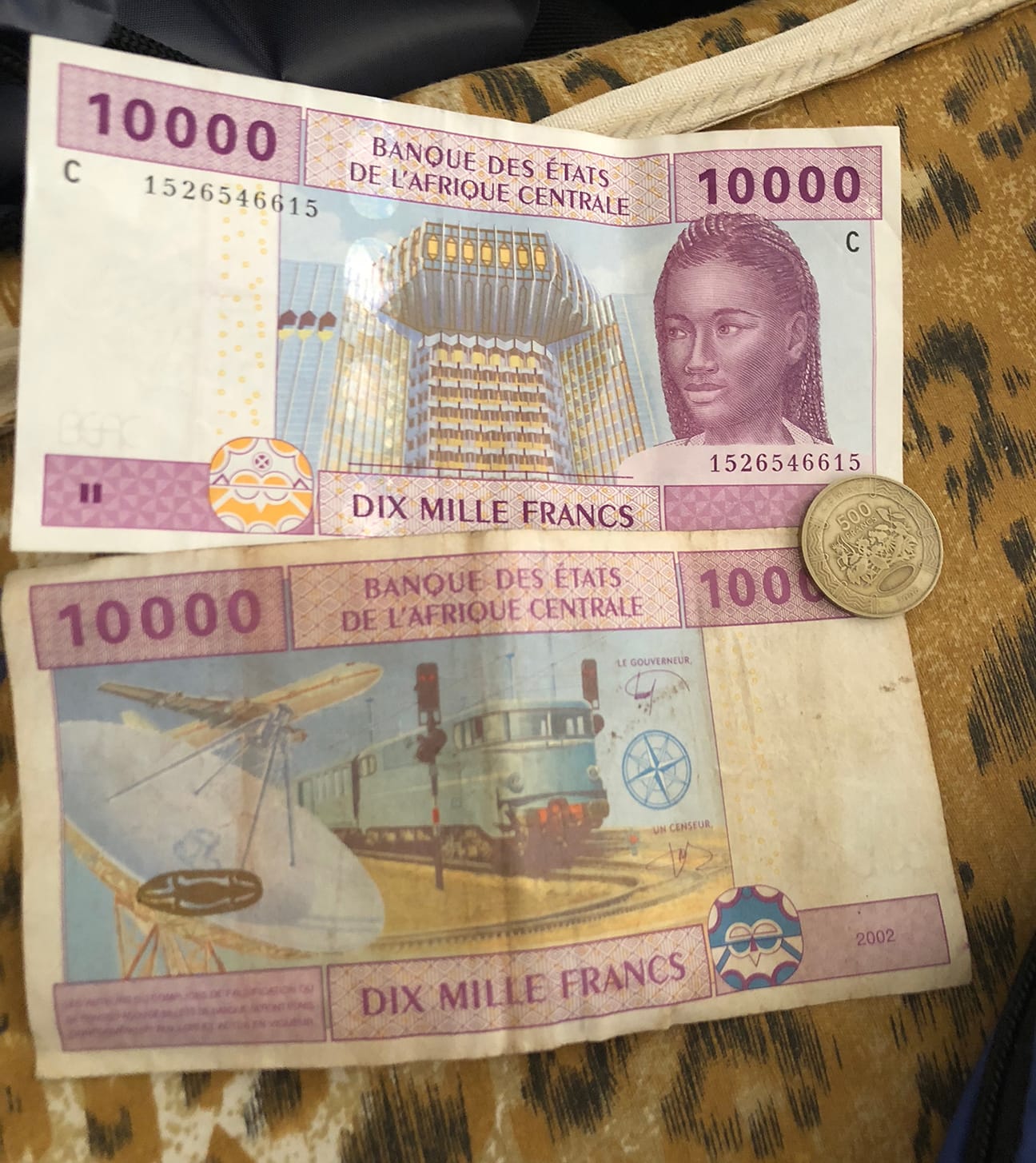
I ended up spending about 45,000 CFA (local currency), which is about $80 USD, and I feel pretty good about my purchases. I bought a couple of leather-framed maps of Chad, wooden animals for gifts, etc. Overall, it was a lot of fun and a very interesting outing.
While driving around, an interesting thing we learned is that N’Djamena is the third-most expensive capital city in the world to live in. Which means that if you want to live a Western lifestyle in Chad, everything will have to be imported, you’ll need backup power, etc., which makes it very expensive to live how we are accustomed to in the U.S.
That evening, we spent a few hours in the hotel lounge chatting. The power went out multiple times over the evening, but it comes back on within 30 seconds when the hotel generators kick in.
It stormed all night long and poured down rain. This part of the country is on the border with Cameroon and is much more tropical than where we are heading to.
Thursday, 7/12/18, Day 4: The Bags Are Here, Kind Of
Low-key day at the Hilton today. We ate breakfast at the hotel around 6:30 a.m. and stayed down there for three hours exchanging crazy stories. I sent out an email to the SPA participants updating them on the trip so far and the delays we are experiencing.

In the afternoon, we went on a mini-safari adventure around the hotel property to practice with our cameras. We saw lots of lizards including skinks and agamas, plus many bird and plant species.
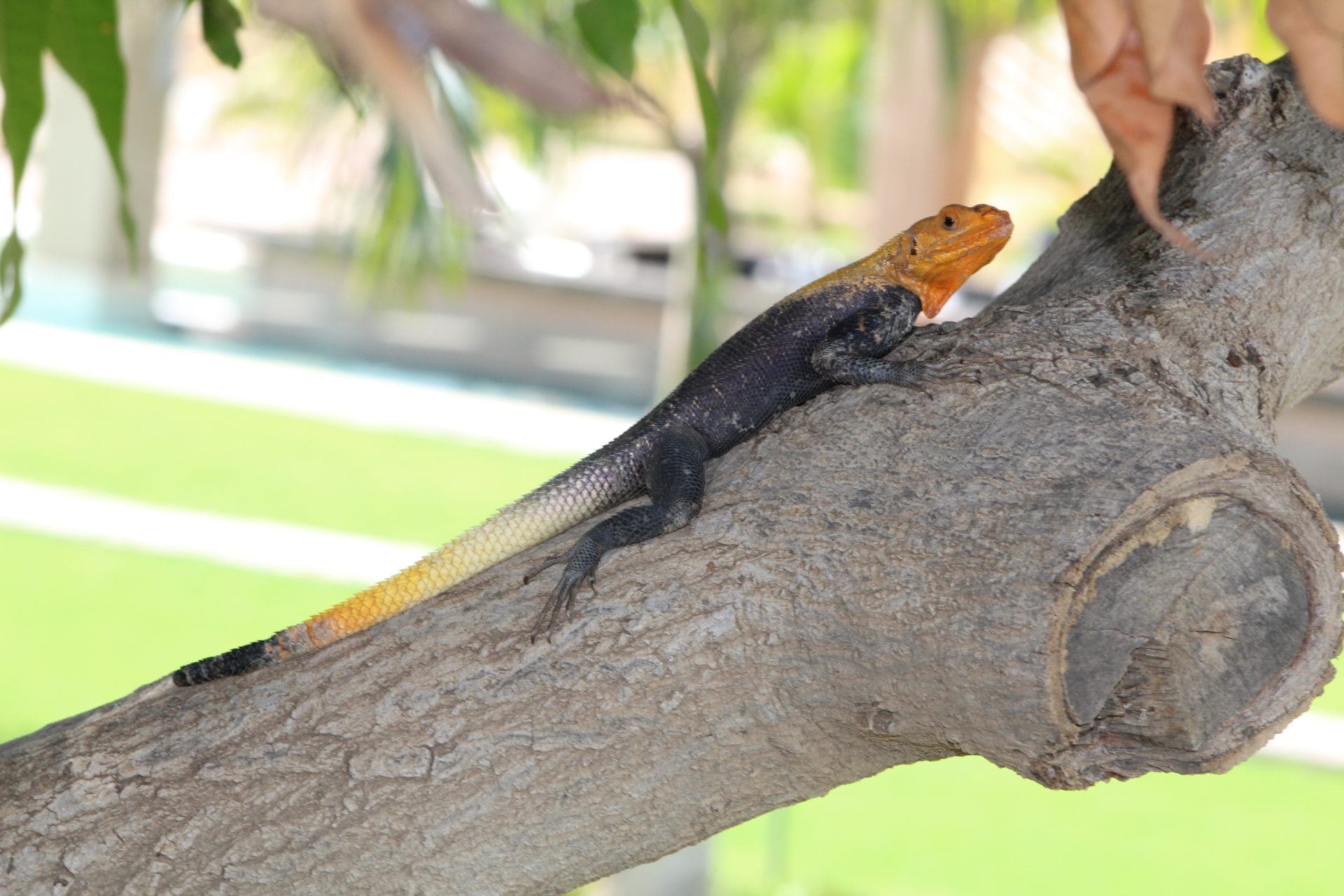
This hotel is very odd; it is huge and very nice, fully staffed at the pool, restaurant, swim-up bar, etc., but there are only about 25 guests in the entire hotel.
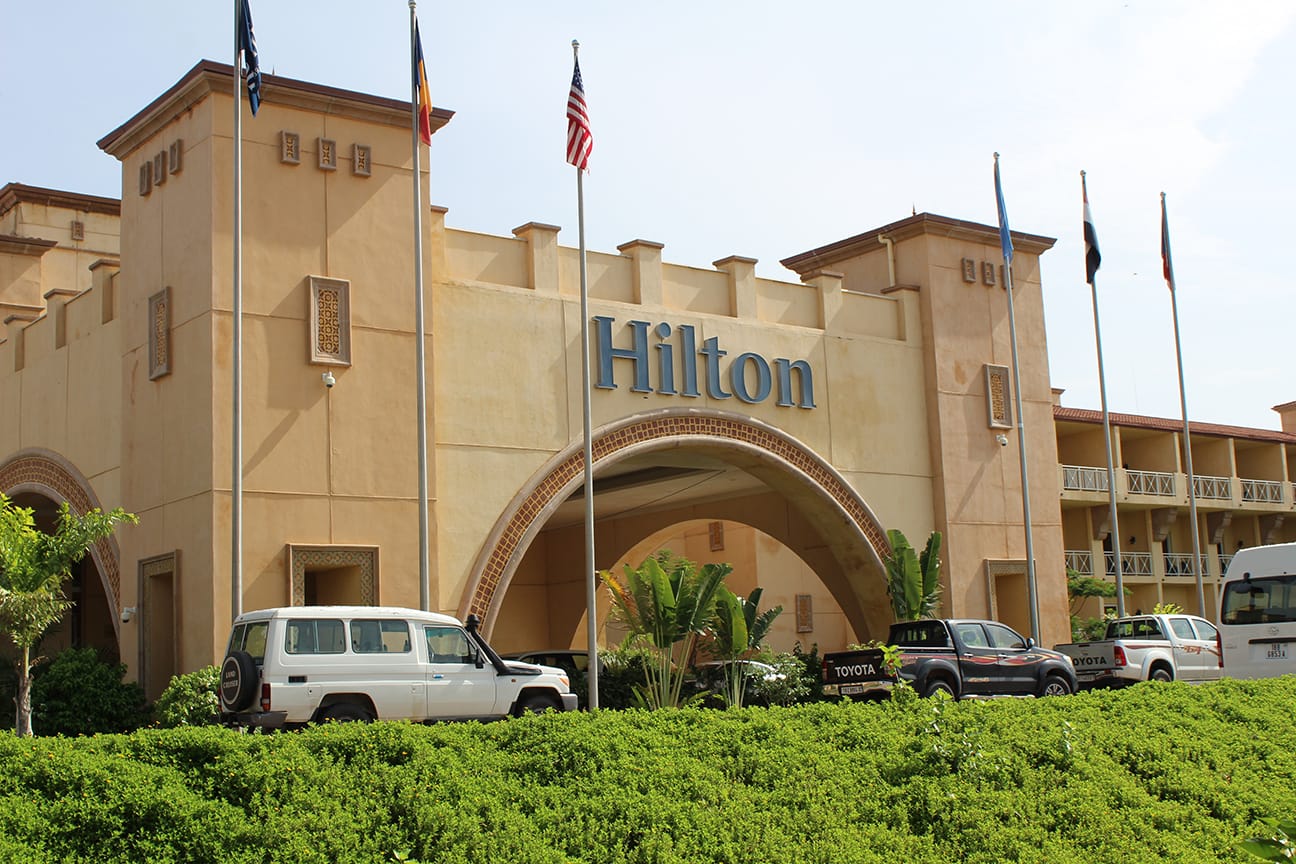
We went to pick up the luggage from the airport after the flight arrived at 9 p.m. Security at the airport seemed unusually high with three checkpoints to even get to the parking lot. When we got to security in front of the airport, Julie realized her passport was in her backpack in the van, so she and Adam went back to the van to get her passport.
I said I would go ahead and wait for our bags – big mistake. I was sent in the wrong entrance and waited for 20 minutes without seeing them. It turns out I was in the wrong spot and quickly found them once I got to the correct area.
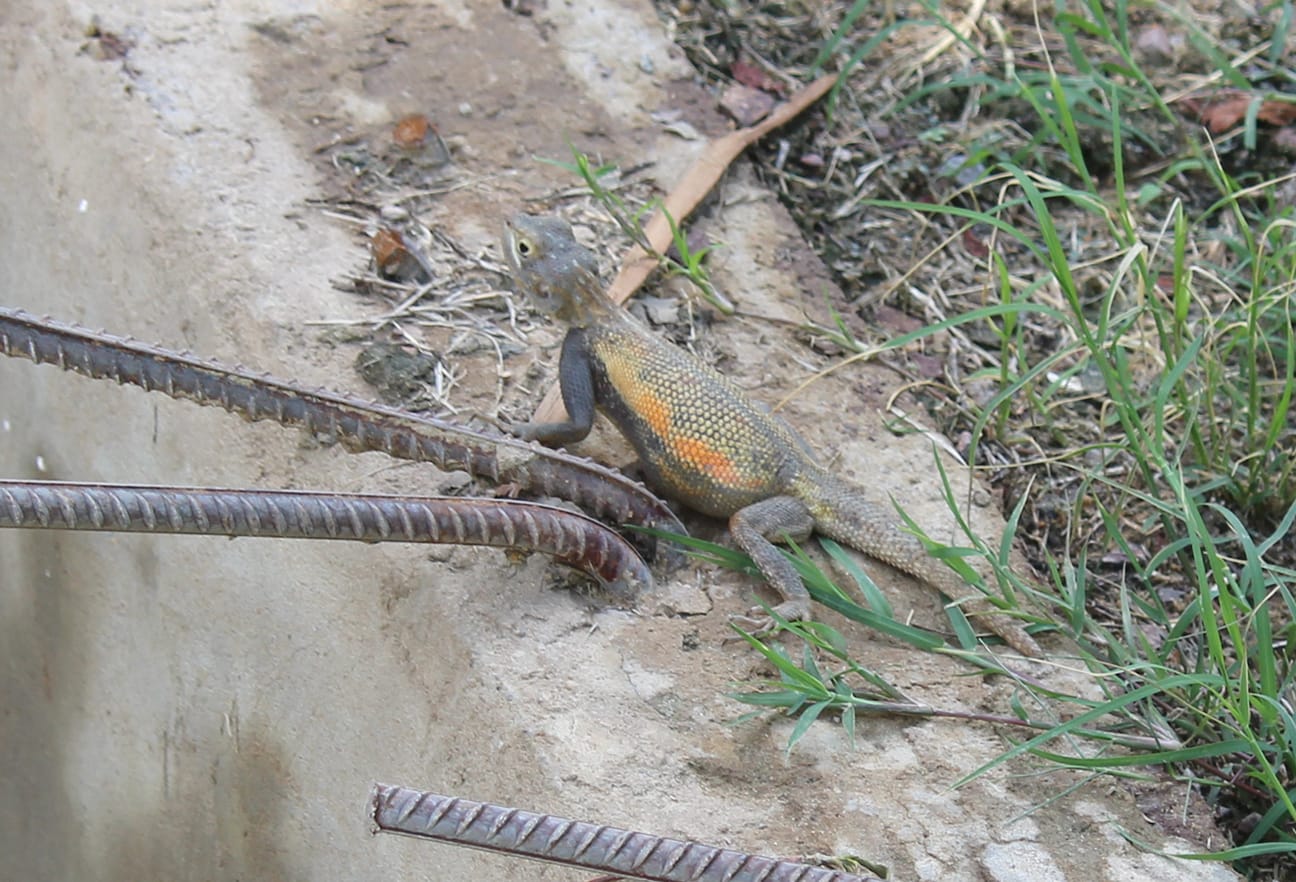
Apparently, the security was so high because a political representative from Cameroon was coming through the airport on state business. When I found Adam and Julie, they had five of our six bags; my smaller Patagonia duffle was missing, which had all of my clothes in it. We waited until all the luggage was out and no bag for me.
So, I went to the luggage office again, and this time the man who was working there spoke only French. From what I could gather using my elementary French class as a resource, my bag should be on the next plane arriving on Sunday. The good news is my large duffle that did arrive has my snacks, tent, bug spray and sunscreen.
Since I have a change of clothes, I can make do until the others arrive. Much harder to find a new tent. Another issue we encountered is damage to Adam’s luggage.
His The North Face duffle has holes in it, and all the snacks and Gatorade powder he has inside have been torn into by something. It is a total mess.
Our new plan on my luggage is to leave my baggage info, passport copy, etc. for Katherine who is arriving from Smithsonian Conservation Biology Institute on Sunday to wait for the GPS collars. If the bag arrives while she is waiting, she will bring it out to basecamp with the collars.
We are leaving for basecamp in the morning at 7 a.m. We shall see what adventures that brings.
Friday, 7/13/18, Day 5: The Road To Abéché
We left the N’Djamena Hilton around 7:30 a.m. in an awesome SCF Land Cruiser truck. SCF sent a driver and an armed guard to pick us up for our journey to basecamp.
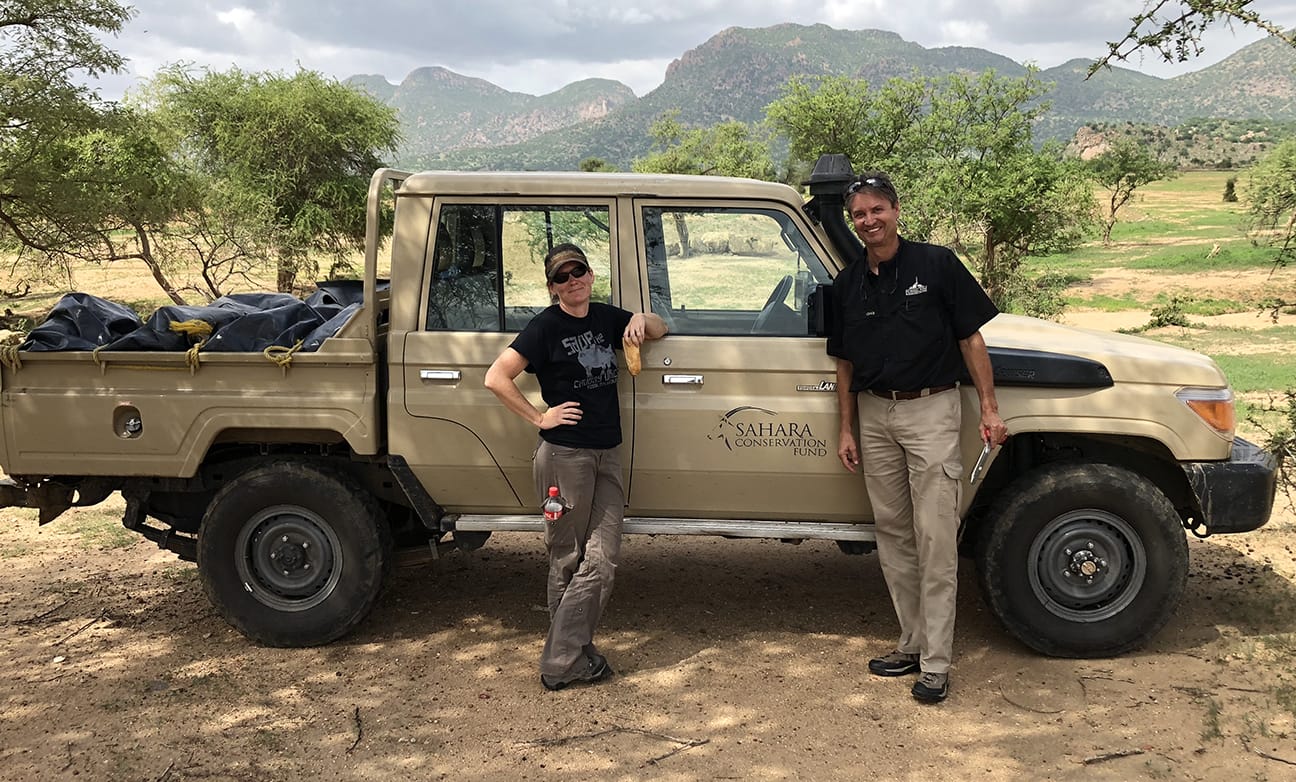
The road was paved most of the way to Abéché. However, the potholes were so bad in some areas of the road that we drove on dirt paths beside the road instead. We passed through dozens of small villages on the way to Abéché.
There was an incredible amount of livestock on the road with herds of hundreds of sheep, goats, cattle, donkeys, and camels being a regular sight. One of the neatest and most unexpected parts of the drive came when a beautiful red rock mountain range appeared out of seemingly nowhere.

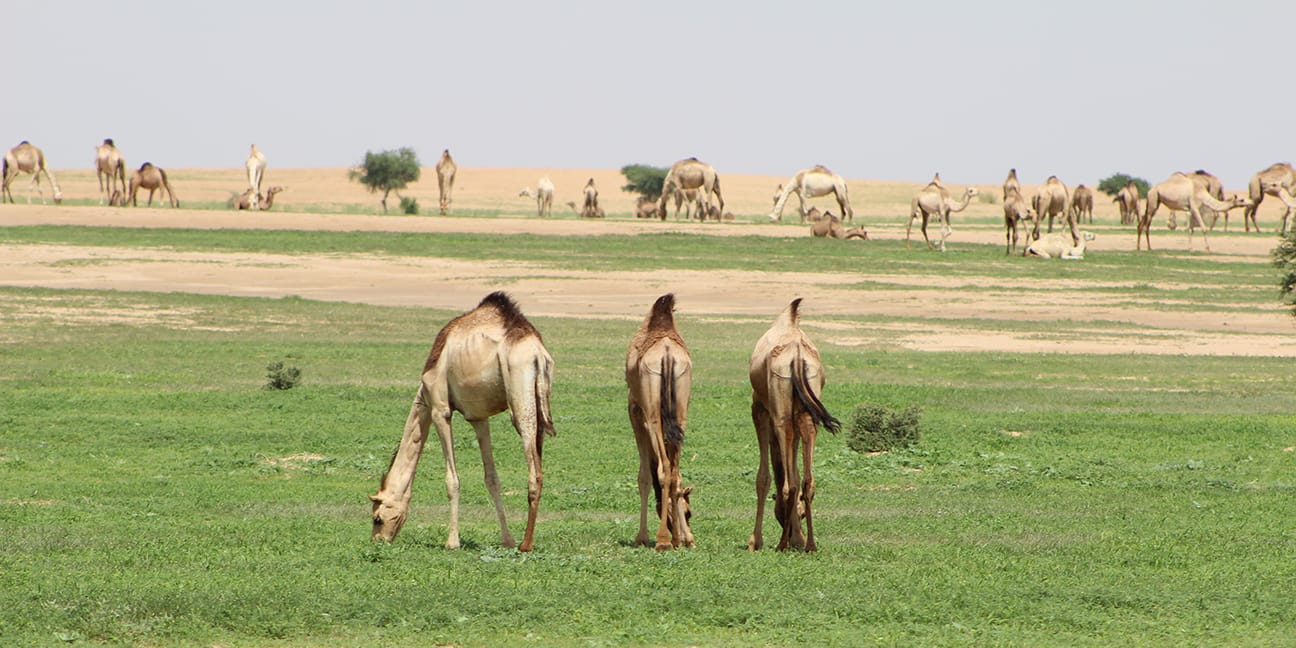
One thing to note here is that traveling outside of N’Djamena as a foreigner requires special government permission. SCF set up our arrangements ahead of time so it was not an issue, but we stopped through many roadblocks where our drivers had to show special badges that indicated our permission to travel.
When we stopped to get diesel and water around lunchtime, the driver Sharif tried to get us to eat street meat for lunch. Adam insisted it was safe to eat, but I took the safe route and stuck with a protein bar and some Oreos for lunch.
There was great birdwatching along the way. During the drive we saw Abyssinian rollers, northern red-billed hornbills, marabou storks, Abdim’s storks, cattle egrets, European black kites, bee-eaters, Rüppell’s vultures, African masked weavers, bronze-winged coursers, Denham’s bustards, and Arabian bustards.
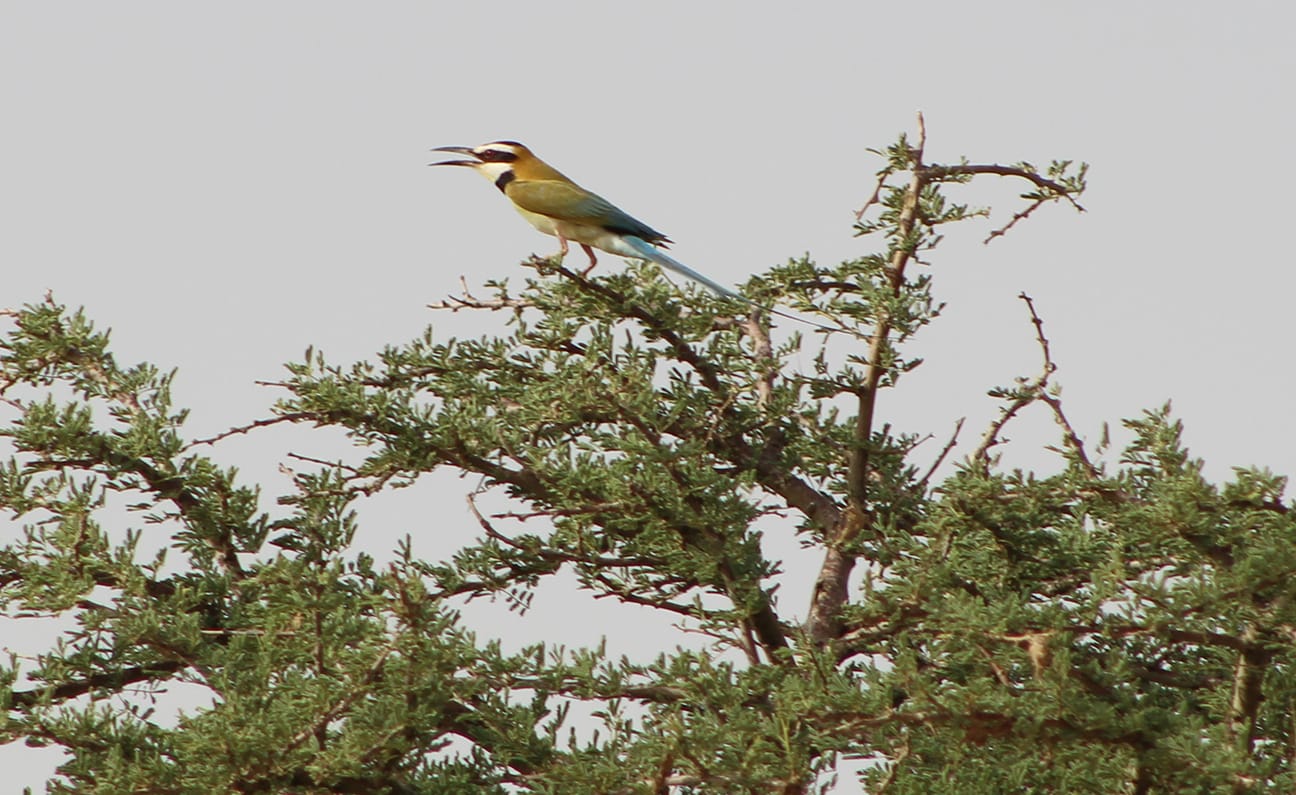
We finally made it to Abéché around 8 p.m. and drove on dirt roads through town. Abéché is the second-largest city in Chad and is a huge center for trade and commerce in the area. We stayed the night at a place called “Hotel Caesar”.
Julie stayed in a single room on one side of the courtyard, while Adam and I shared a double room on the other side. We had dinner there of chicken and fries, which was delicious and the beers were cold.
Saturday, 7/14/18, Day 6: “Basecamp Oryx”
The drivers arrived in the SCF truck to pick us up from the hotel around 6:30 a.m. The rest of the five-hour drive to basecamp was basically all off-road on desert tracks, so it was an extremely rough ride. They had received some rain in the area recently, so we saw lots of bustards, ibises, and other birds on this part of the drive.

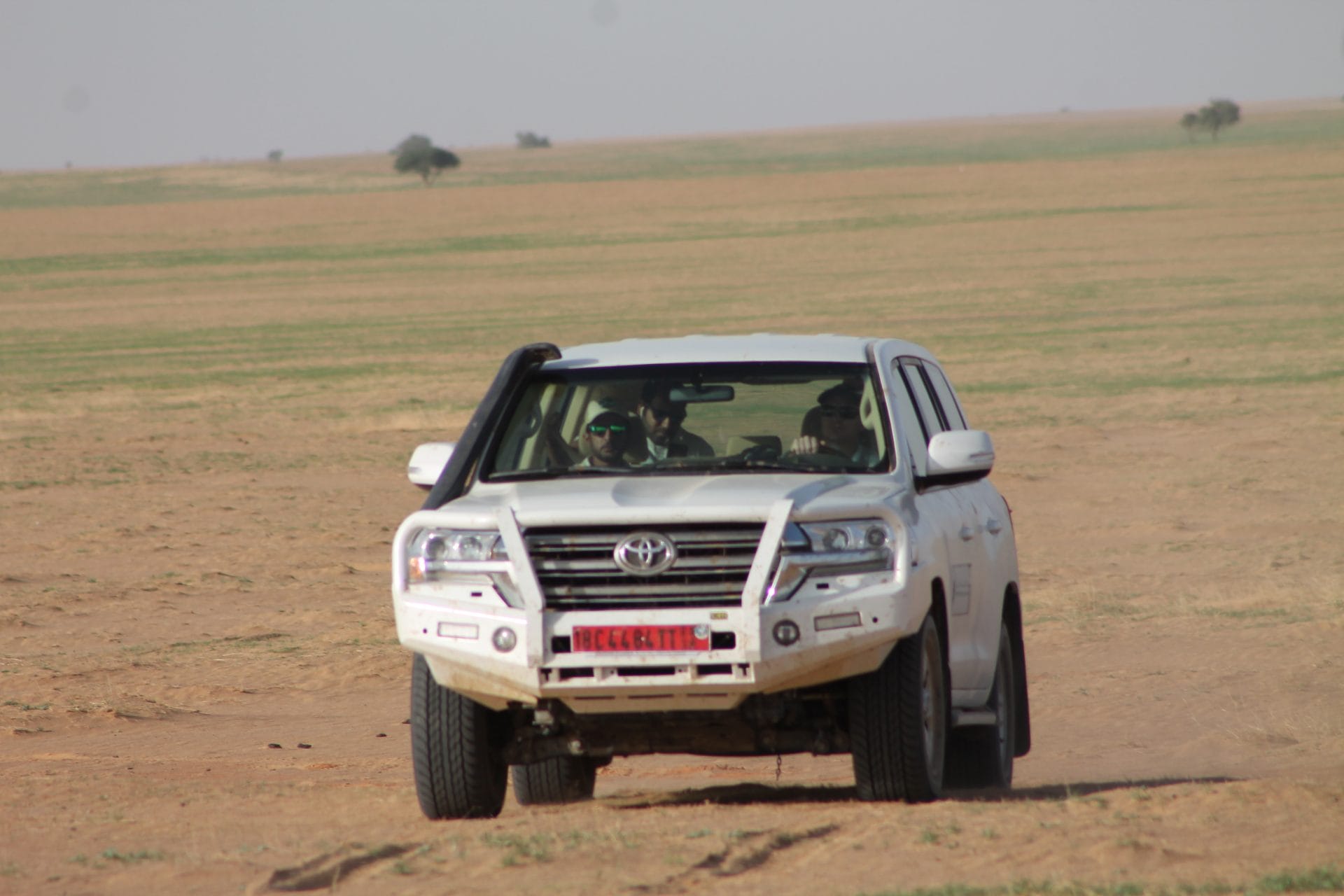
The farther north we went, the more camels we saw. We definitely encountered over 500 camels on the way to the reserve today. At one point, Sharif stopped the truck and bought a water bottle full of fresh camel milk to drink from one of the nomads. As we neared the huge Ouadi Rimé-Ouadi Achim Faunal Reserve, we spotted the first dorcas gazelle of the trip, and right near basecamp, I saw our first wild scimitar-horned oryx (SHO) – a big bull with a GPS collar still on.
Basecamp Oryx is located in the south-central area of the reserve and is surrounded by eight-foot-tall game fence. It has buildings made from retrofitted cargo containers, two round shade huts for us to sit under for meals, and is powered primarily by solar and wind, with a generator if needed. Another small camp is located near the basecamp, and it houses the rangers and guards for the reserve.

As soon as we got to camp, we had lunch with the rest of the group that had already been there for two days, and then we went and set up our tents behind some of the cargo containers near the wind turbine. We left for our first oryx tracking trip at 2:30 p.m. with the idea being that we would track the herd that is the farthest from camp – the 2016 release animals. It is at least a two-hour drive each way to get to the area this herd is at.
I rode in the EAD V8 Land Cruiser with Justin, who runs the EAD project. On the drive to find the oryx herd, we saw well over 200 dorcas gazelle, which was an awesome and unusual sight.
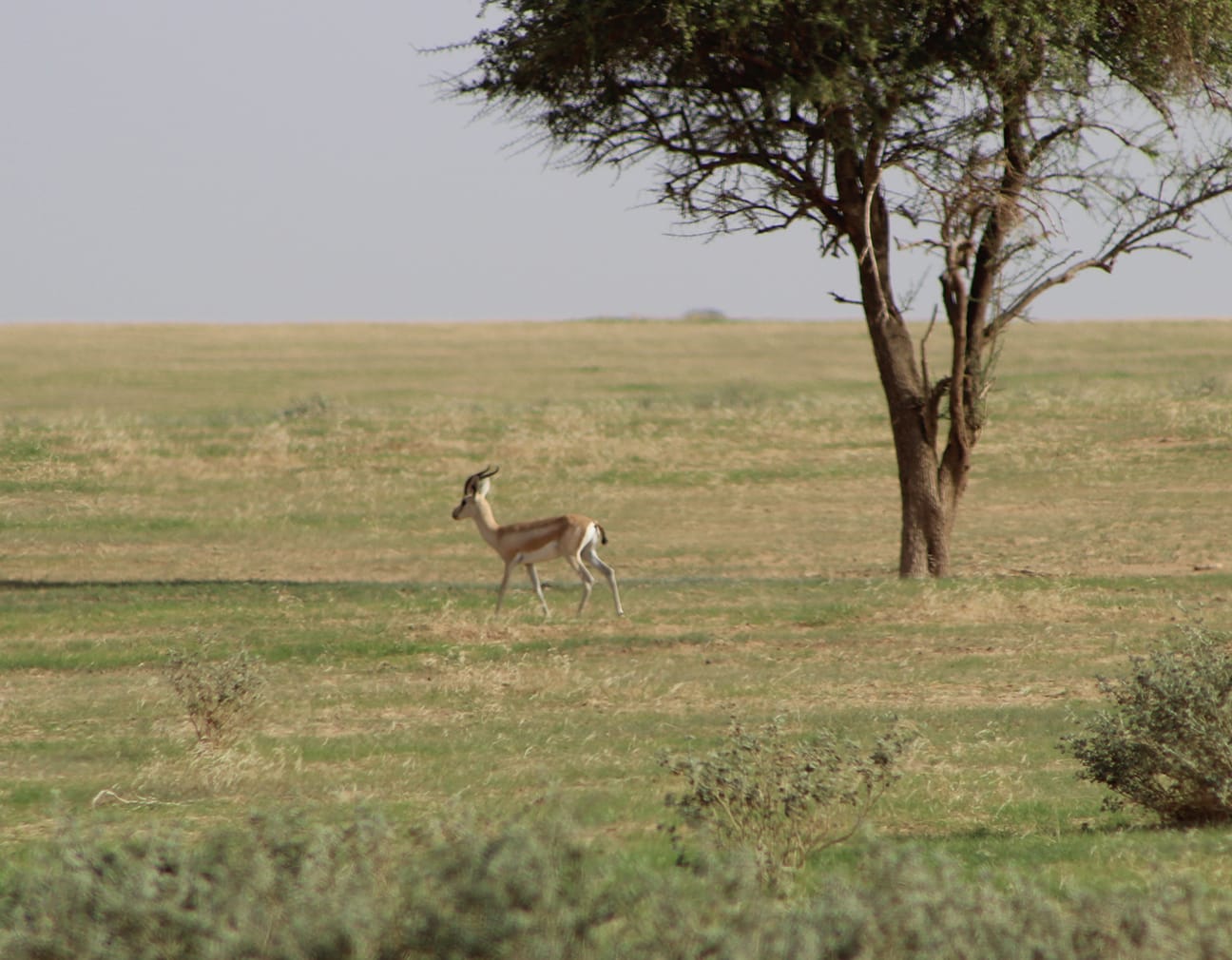
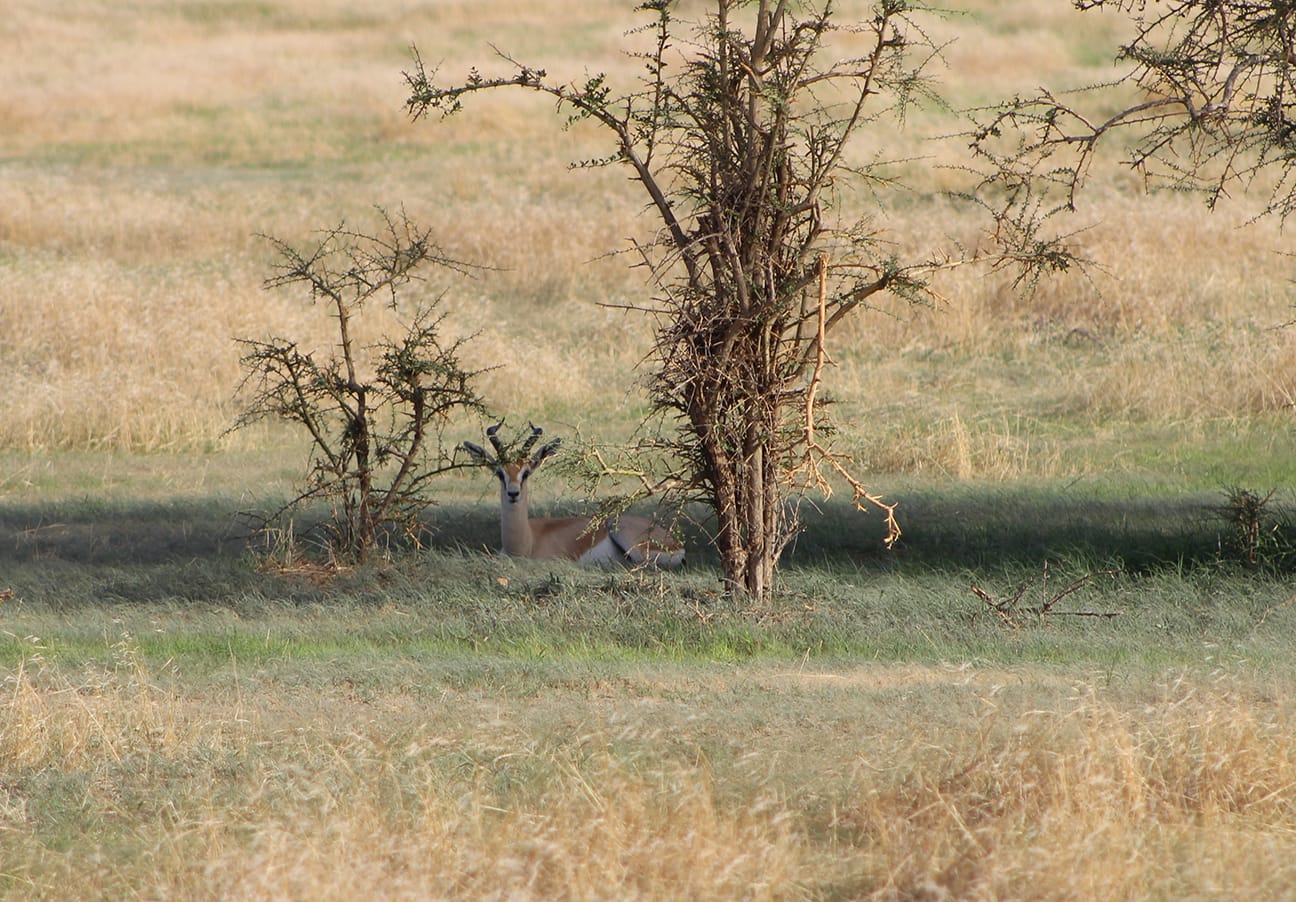
Near dusk, we had our first sighting of wild SHO. We saw the herd of 18, of which all but one are 2016 release animals that have had their GPS collars fall off by design. Luckily, a 2017 single SHO joined the herd and this is how they are tracked.
This herd looks very good and all oryx are in excellent body condition with about six calves amongst them. One of the cows has a female calf from last year and a new calf from this year in the herd. This herd is comprised of animals from the “world herd”, including both U.S. and Abu Dhabi-born SHOs.
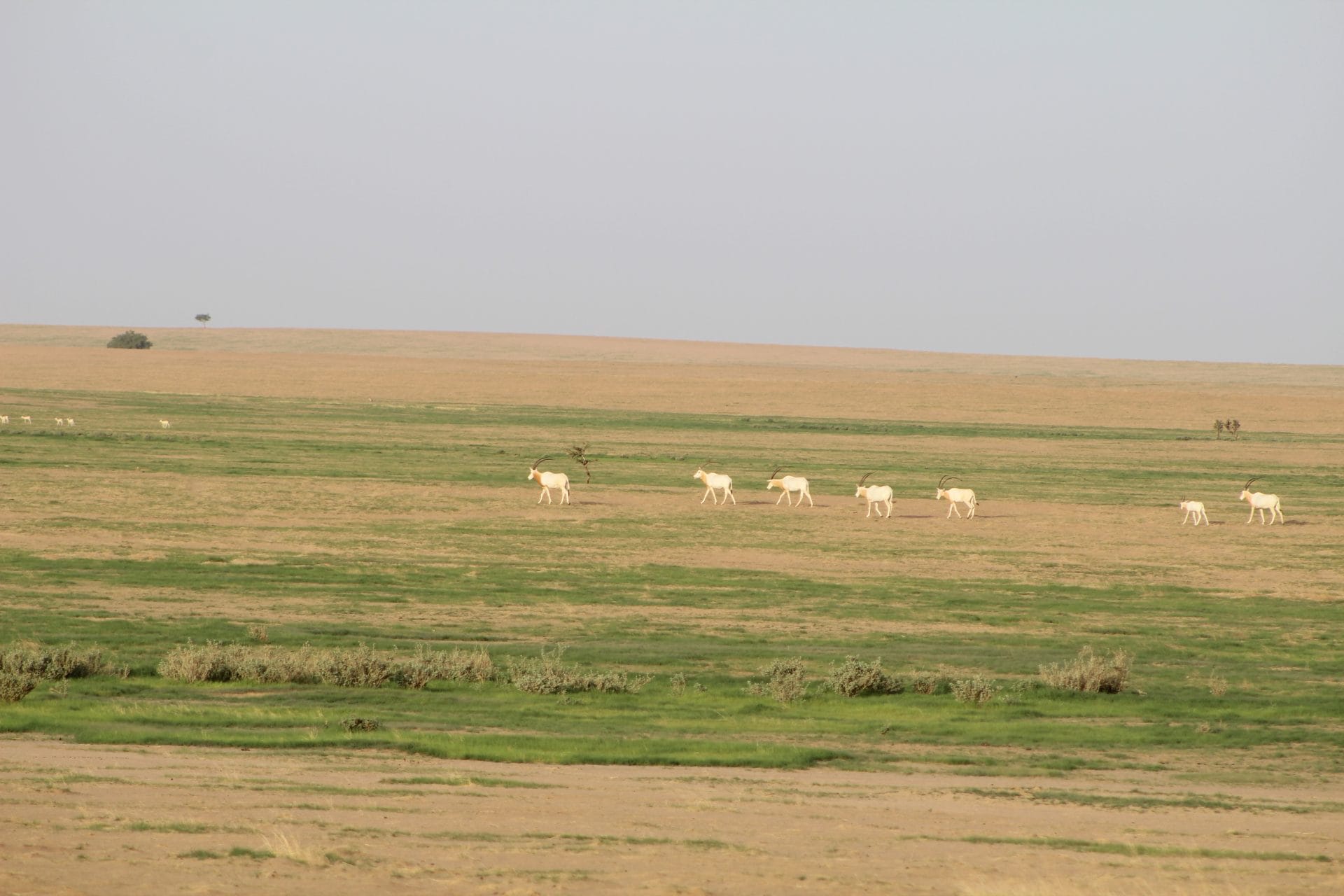
This group is the most cautious of humans among any of the release animals and doesn’t let the monitoring vehicles get very close to them. They have never come back to camp like some of the other groups and seem to have adapted to the habitat well.
It was truly inspiring to see these oryx back in their native range where they have been extinct for several decades, and it is even more exciting to know that Source Population Alliance (SPA) facilities were involved in making this happen. On the drive back to camp, we spotted a family group of five pale foxes, which was really neat to see!
Dinner was cooked by the SVS Outfitters crew. We each had a chicken thigh with French fries and orange slices. The chicken tasted okay, but appeared to have had a very hard life.
The first night of tent camping was not exactly ideal; it was extremely hot without a bit of a breeze. About an hour after we all got into our tents, it started raining lightly, so we each had to put our rainfly on our tent to keep the rain out. Out of nowhere, the slight rain turned into heavy rain and then came 60-plus mph winds.
I was doing my best to hold onto my tent and keep it from breaking in the wind, plus I had my arm outside the tent holding the rainfly down after it became unbuckled. Also, because this is the desert, the tents were being sandblasted the entire time with wet sand. As soon as there was a short lull in the wind, Justin and Ric came over and told us it was time to head inside.
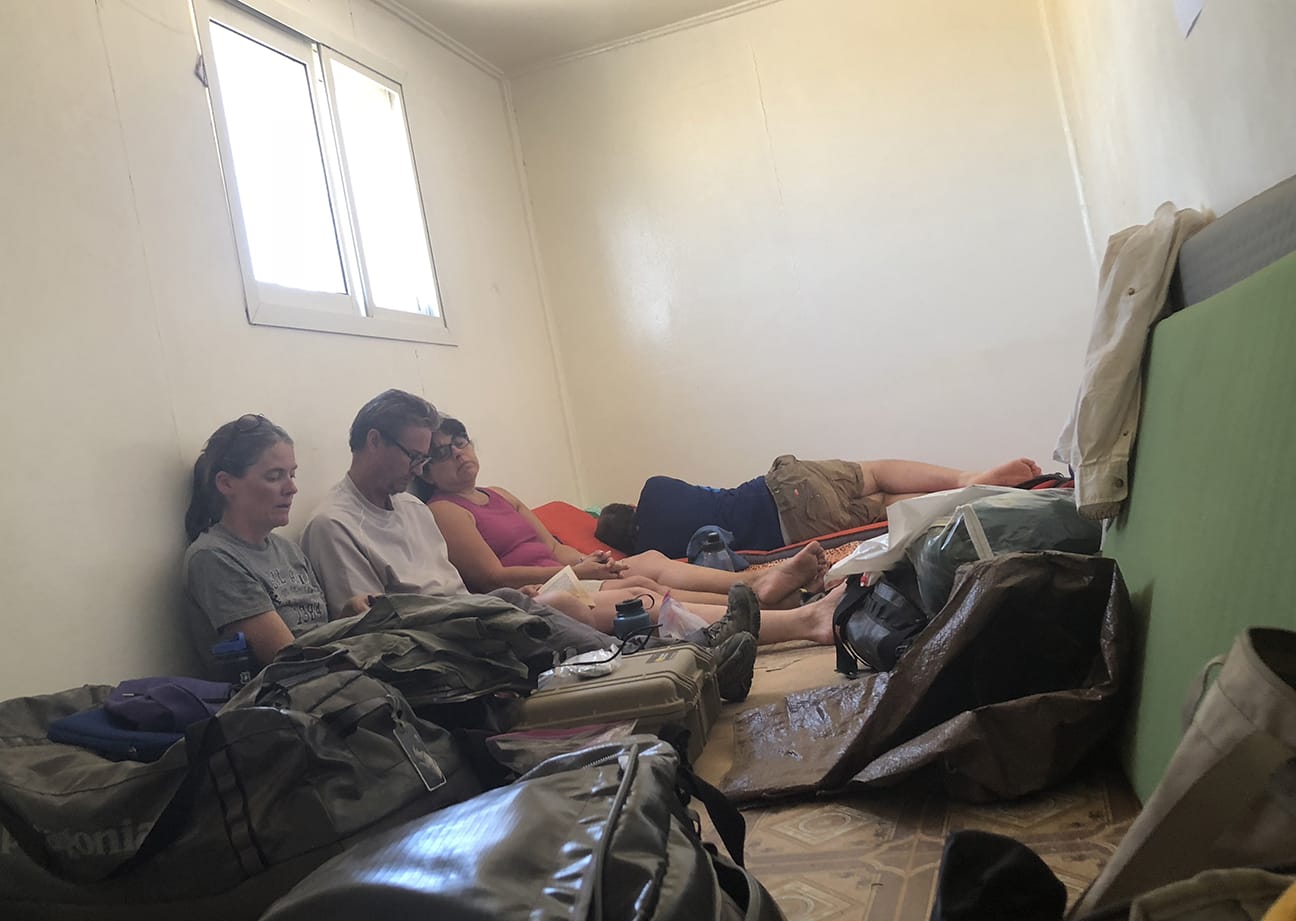

They helped Julie bring in her supplies, and then Adam and the guys helped me drag my camping equipment into one of the cargo containers. I was hoping to try and ride out the wind, but that was obviously not in the cards. We slept in the guys’ cargo container/bunkhouse.
The good part is that it was slightly air-conditioned and we just put our camping mats on the floor and slept in there for the night. The real bummer is that since the door was open for a bit while we were rescuing our camping supplies, the container was full of bugs.
Sunday, 7/15/18, Day 7: Game Drives For Days
We got up around 5:30 a.m. and went out to the common area to sit under the shade and have breakfast. It was already hot, but there was a nice breeze. I sat and talked with Justin and RoxAnna for a while.

Ric and Justin decided to go ahead and make some adjustments to the catch pens for the oryx we will be collaring. Adam and Julie went down to help them, and since there were plenty of people working on that, I went with Newby, Thomas, RoxAnna, and a group of visitors from the Chadian government to go track a herd of oryx.

It turned out to be a good game drive and we were able to get really close to the oryx herd made up of 2017 release animals. We saw 21 oryx in a big group that was fairly close to the pre-release holding pens. It was great oryx watching, and I got some good pictures of the group.
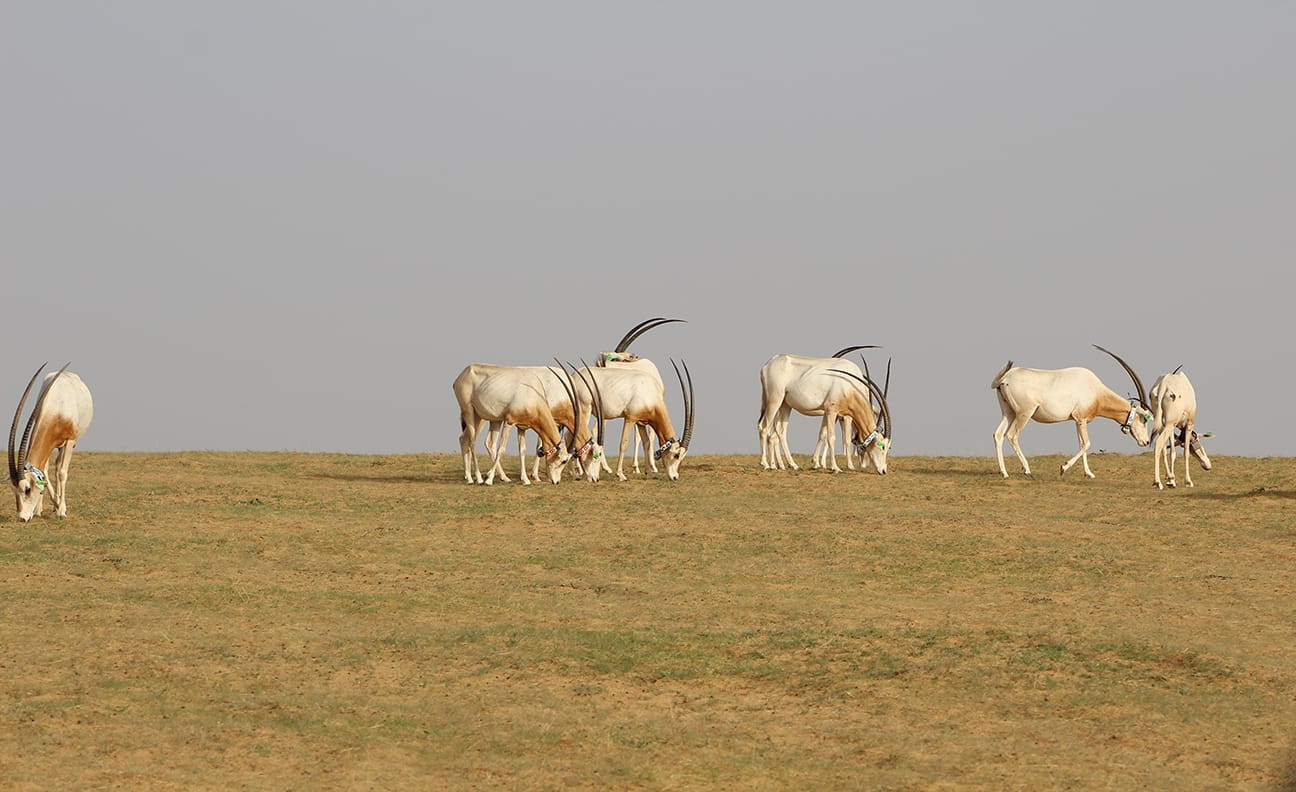

On our way to find the next group of SHO, we saw six dorcas gazelle, and then found a group of five SHO under a shade tree. It was already really hot out. Three of the five SHO were in excellent body condition, one was in okay condition, and the other was quite thin.
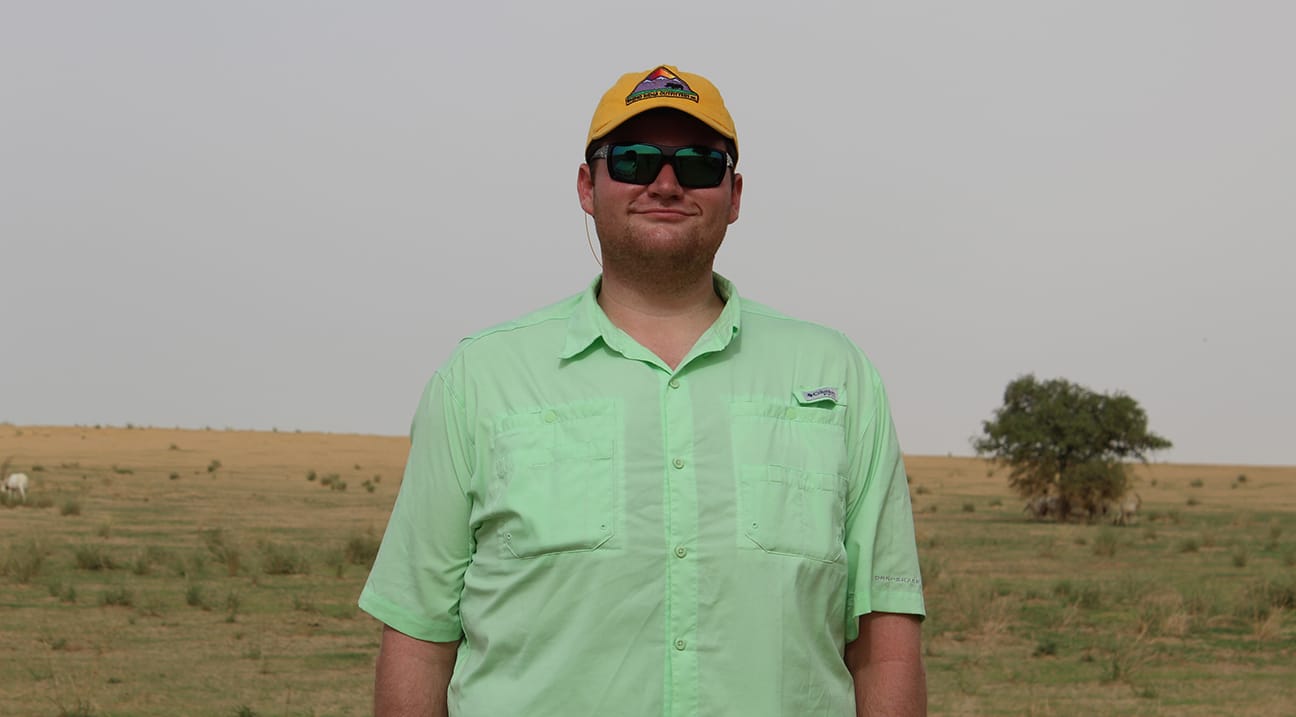

One of the really encouraging things was how interested the men from the Ministry of Environment and Fisheries Chad were in the oryx and the tracking of their radio collars with the very high frequency signal.
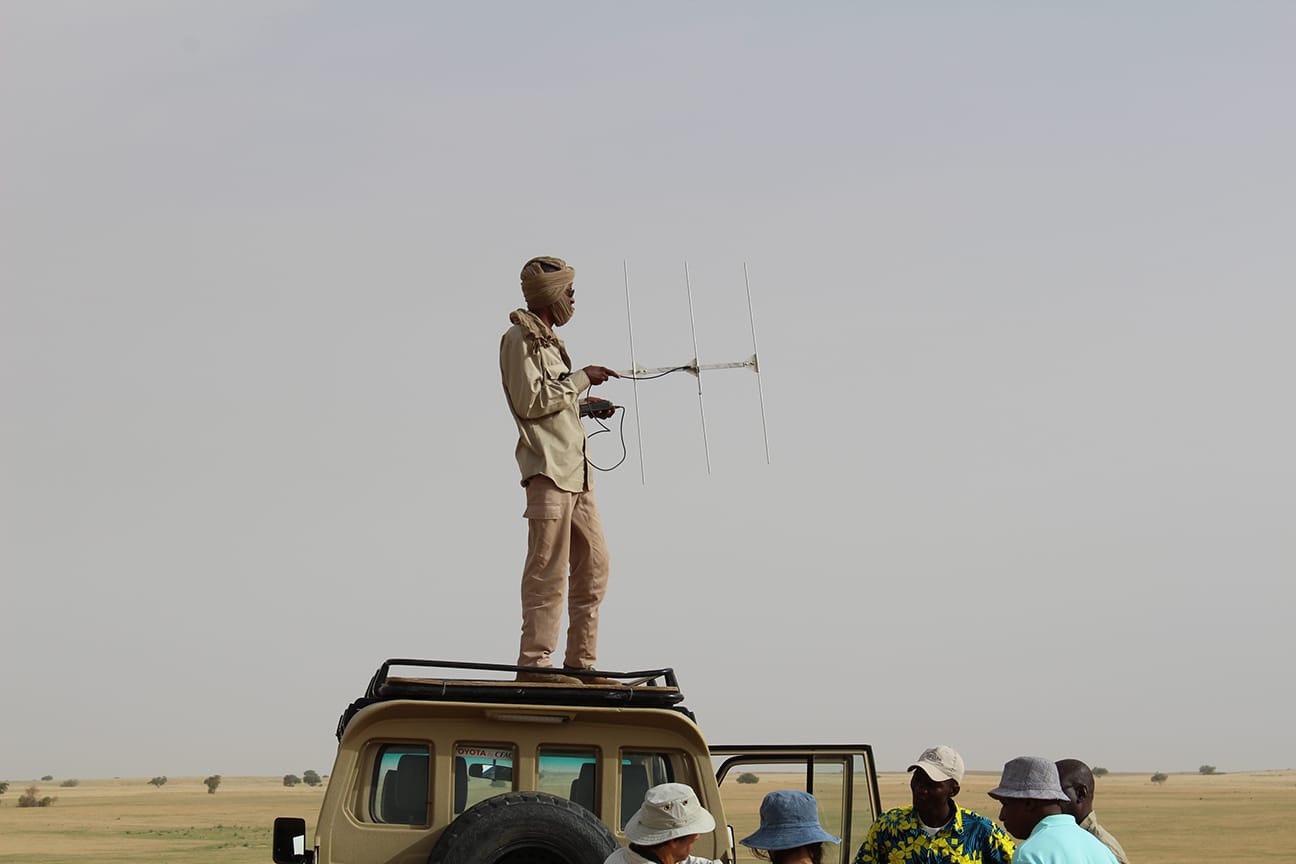
On the way to find the last group of oryx for the morning, we heard a thumping sound. We had a totally flat tire on the front right of Newby’s truck. Newby and I made fairly quick work of the situation though, and got the tire changed to a spare.
Tomorrow, we are planning on starting an overnight trek farther into the reserve to the Wadi Achim and Wadi Karma – two seasonal wetland areas that have historically served as oryx and addax habitat during the dry season.
Monday, 7/16/18, Day 8: “Off To Buy A Sheep For Lunch”
Big travel day in camp – we are heading out for an overnight trip up north to the wadis and are tracking oryx along the way. Everyone in camp decided they wanted to go, since there is nothing to do while we wait for the GPS collars to arrive. Since so many people are going on the trip, it was a huge production getting the vehicles and gear ready and loaded.
In total, we had 15 guests, plus guards, cooks, and support staff for a total of 31 people in nine vehicles. We certainly do not travel light. Julie is unfortunately sick today, but decided to be a trooper and come on the trip anyway.
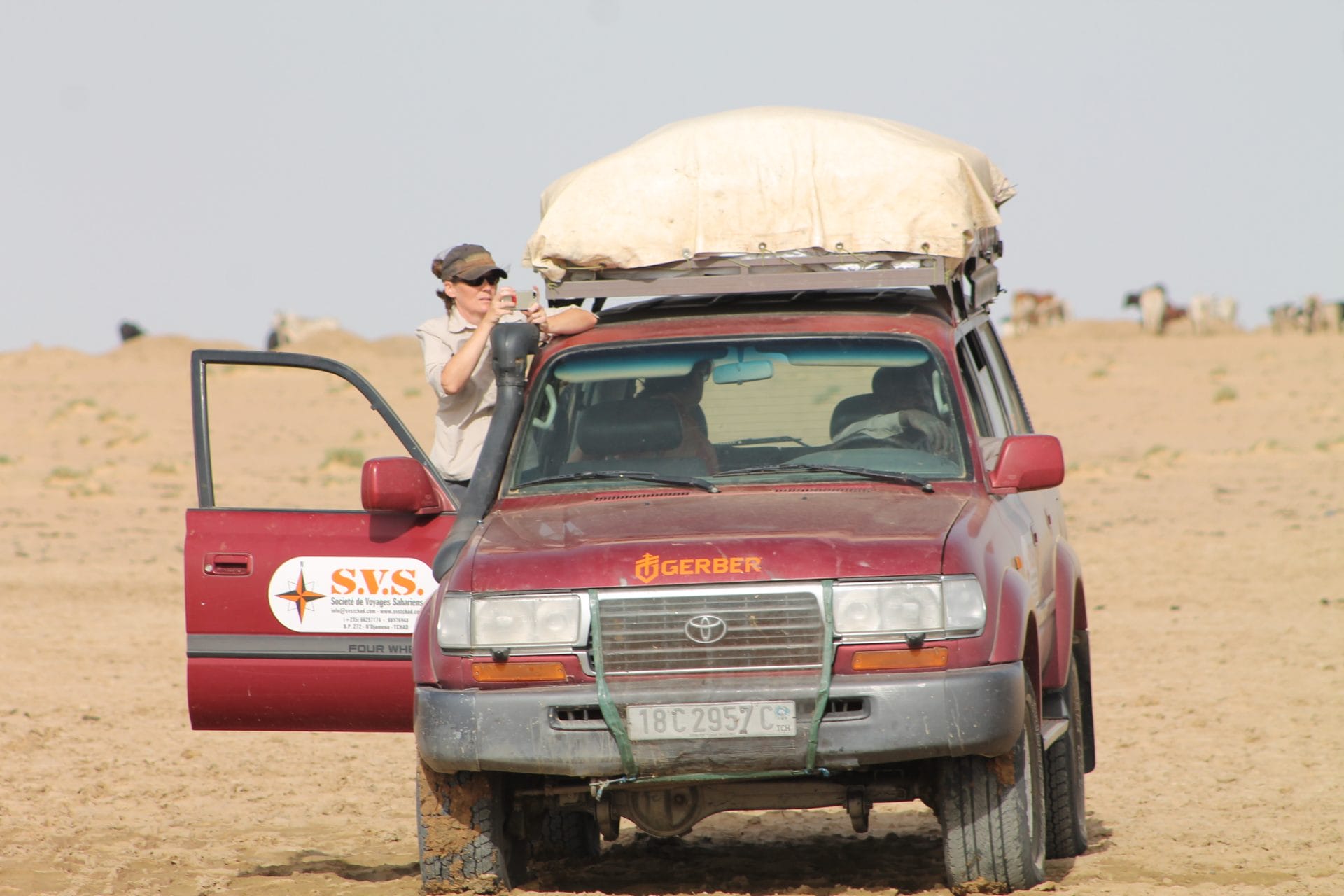
I rode out with Dr. Tim Wacher, the wildlife tracking specialist from the Zoological Society of London who works on the project. Tim has an absolutely incredible knowledge of the local wildlife, especially birds, so it was a great opportunity to get to track oryx with him.
As we ventured farther north, it became increasingly desolate and made the basecamp area look like a prairie in comparison. Before we found our first oryx, we stopped at a huge watering hole that is naturally occurring but has been dug out by bulldozers to retain rainwater. There were hundreds of camels, sheep, and goats all drinking in this one spot.
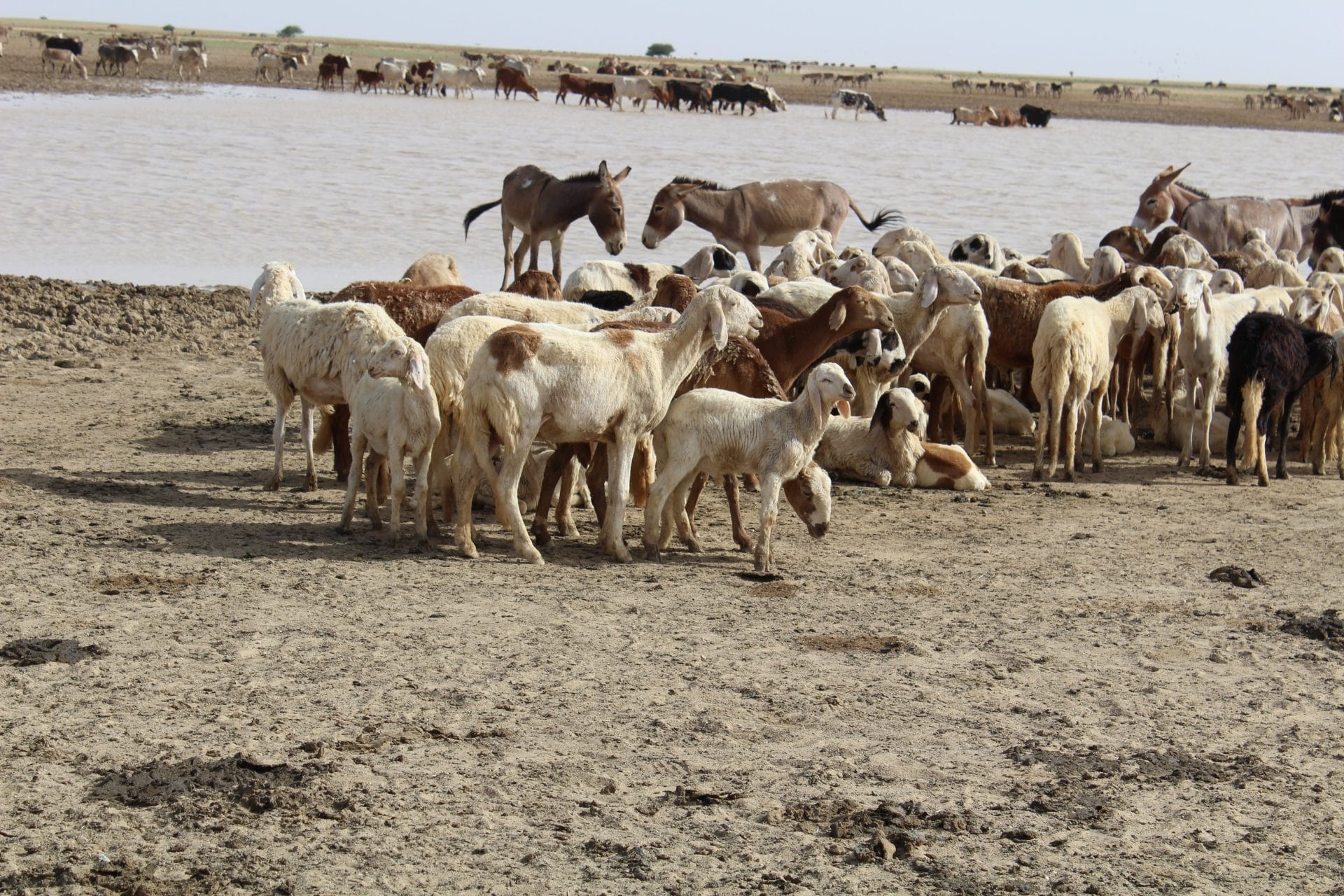

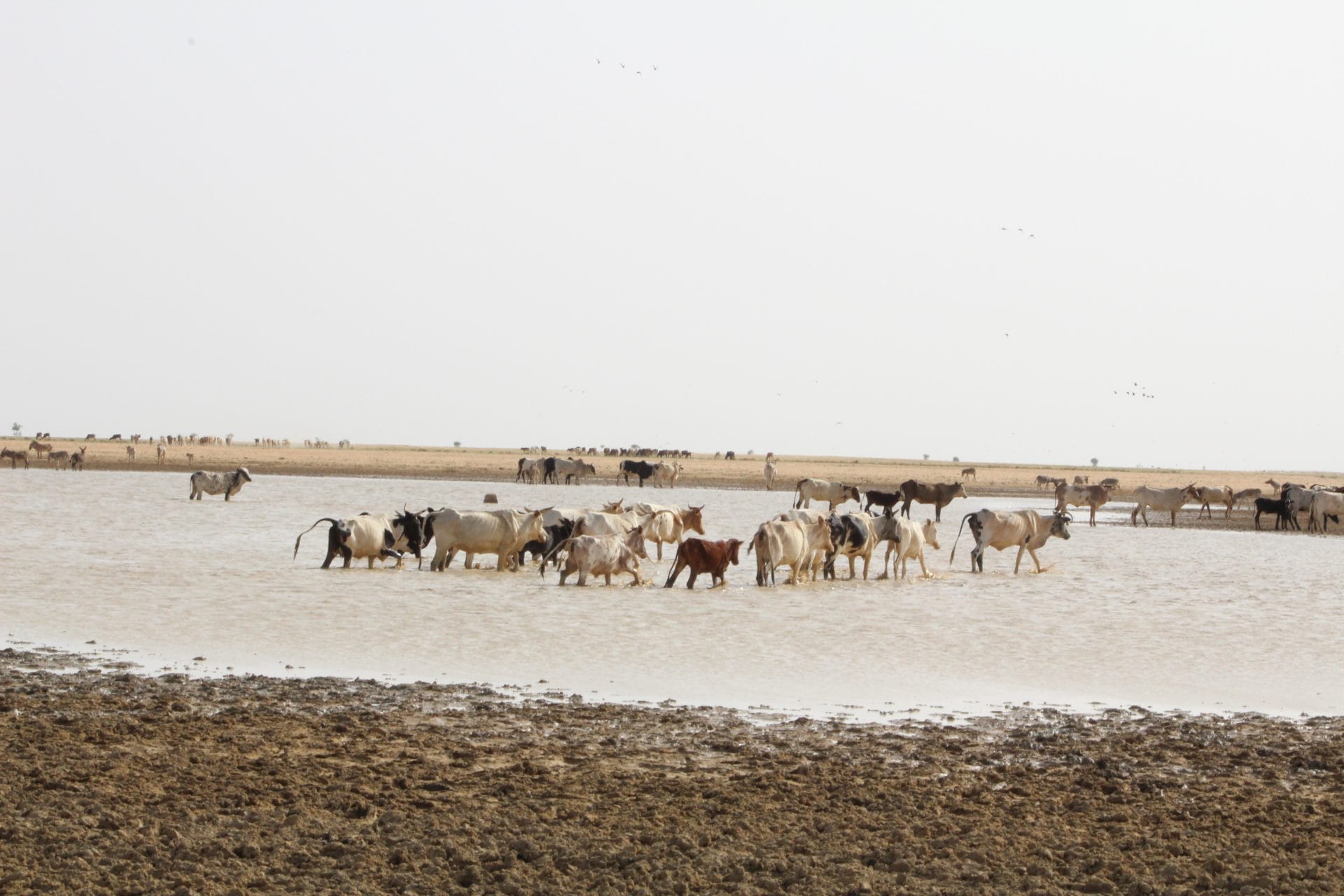
Soon, we picked up the signal of the lone SHO cow that we were tracking. This cow has a history of going off on her own and being in poor physical condition. She is from the 2017 release group and had a bull calf 10 days after being released, which put her at a disadvantage.
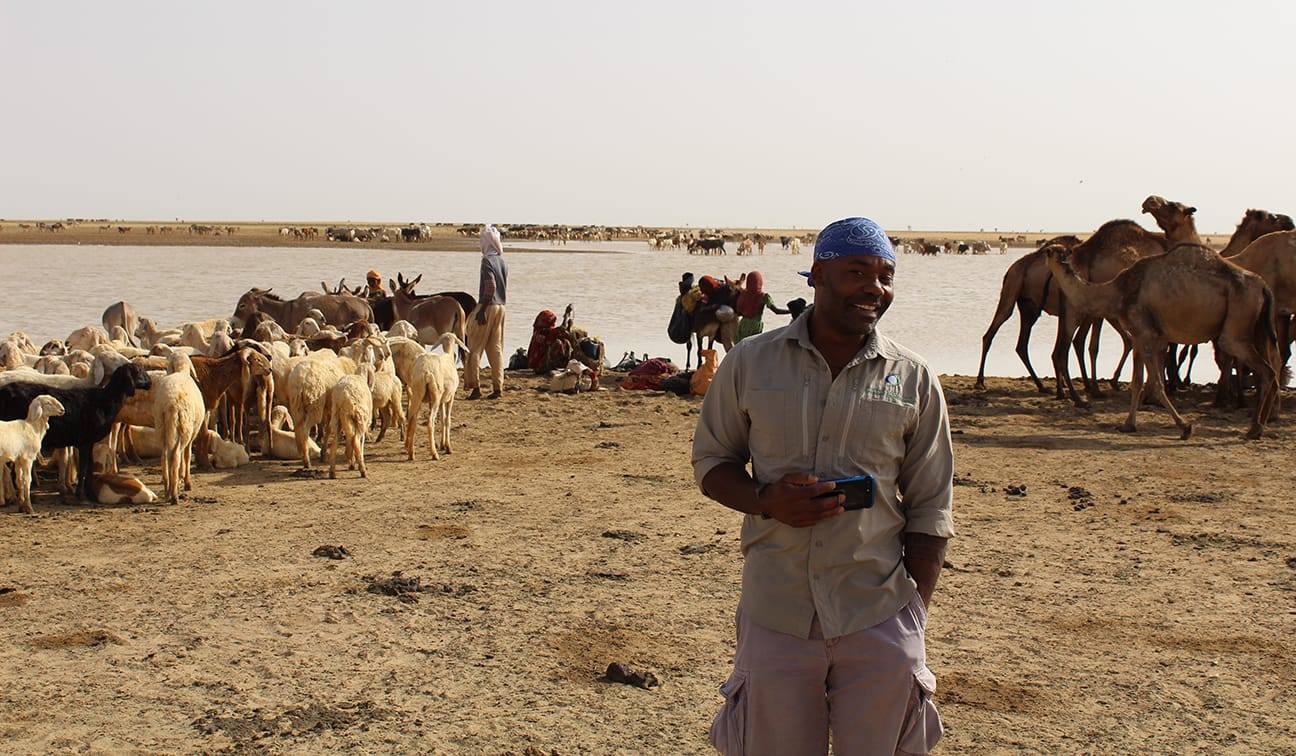
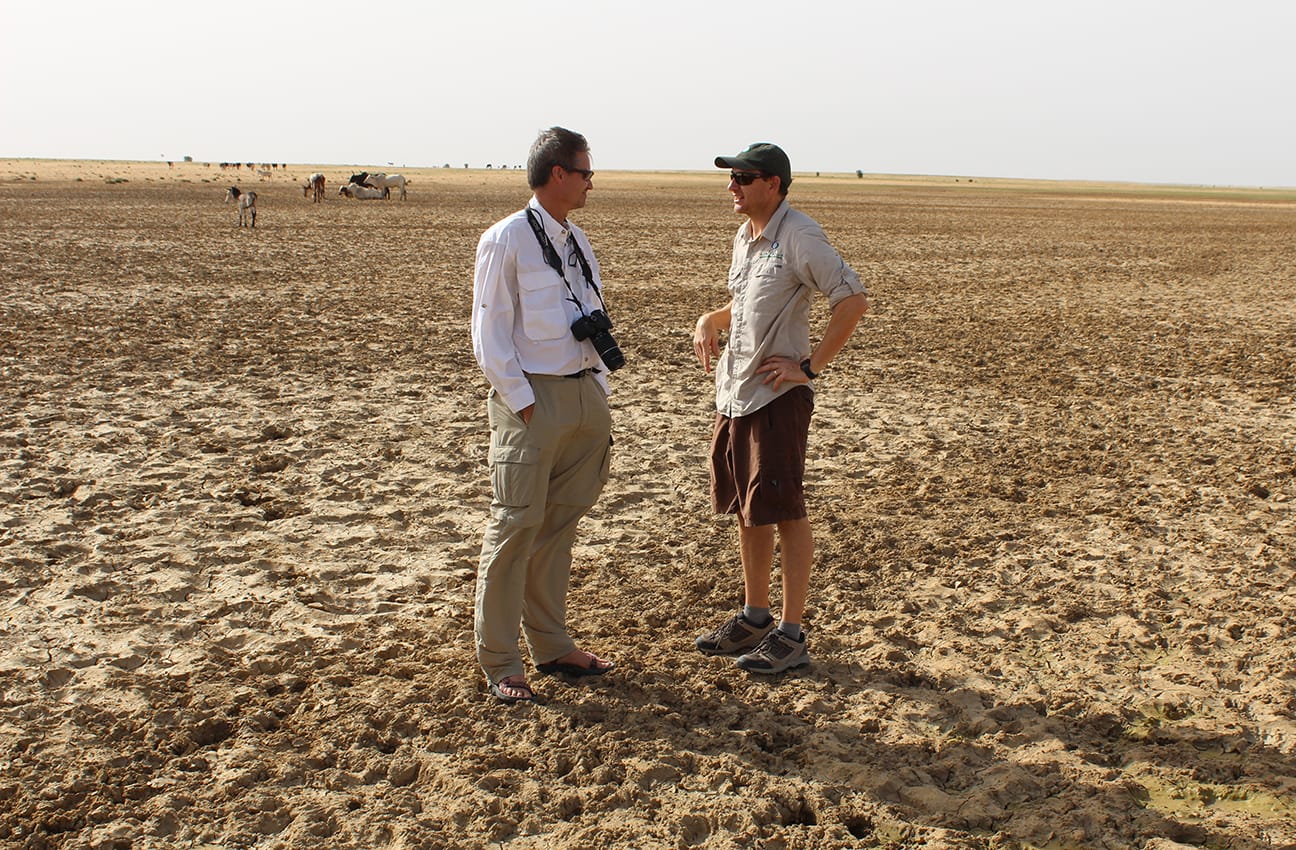
When she went off on her own with the calf, the local staff provided her with some supplemental water to keep her going during the dry season. Eventually, she joined the 2016 herd and in April she had a calf, but lost it within a week. After losing the calf, she took off on her own again.
When we found her, she was 59 kilometers from basecamp and 39 kilometers from the nearest SHO. She is in a very desolate area, but near the big watering hole we visited. She was under a single tree trying to stay out of the heat; her collar number R40 was clearly visible.
We made our first big stop of the day for lunch in the Wadi Karma. The wadis are a lot like arroyos in the Southwestern U.S. A wadi is a dry riverbed area most of the year, but then fills with water that comes from mountains to the east. This area is dominated by two large wadis that run parallel.
The notable quote of the day came when it was announced that the guards were “off to buy a sheep for lunch”, a phrase one only would hear in the non-Western world. We stopped in a shady area of the wadi for two hours to have lunch and got some good wildlife watching in during the break. Ric found the only snake of the trip, a small carpet viper hiding under a tree not far from our lunch spot.

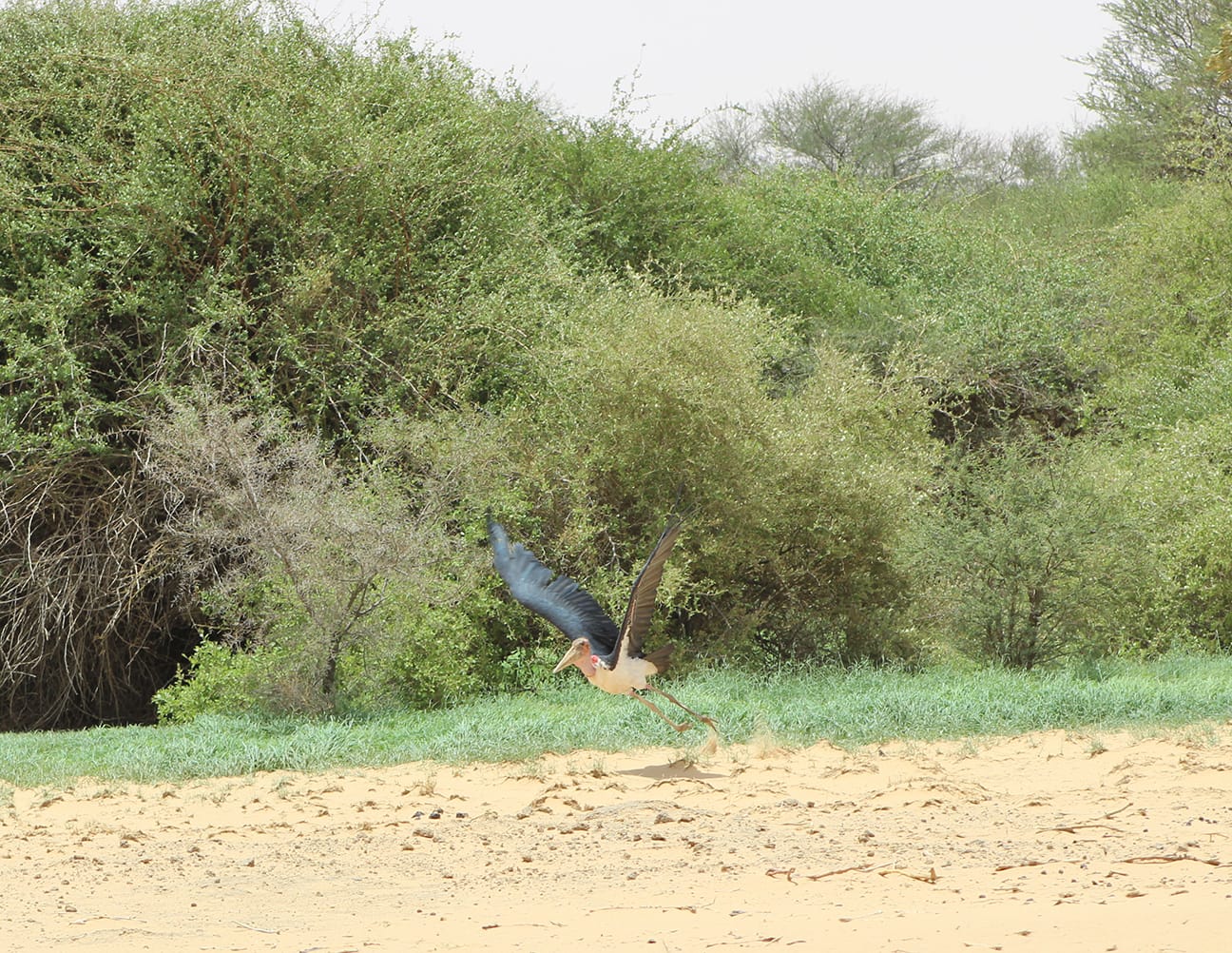
In the area surrounding the wadi, we saw seven dorcas gazelle, 30 marabou storks, two Egyptian geese, Cape turtle doves, African collared doves, and three species of bustards. The most exciting find though, was a freshly dug aardvark den. John told us that it also wouldn’t be uncommon to see warthogs in the wadi – not something I thought we would ever see out here.

After lunch, we crossed the wadi in a dry area and headed northwest toward the Wadi Achim. The wadis function like one green oasis parallel to the other, with a 20-kilometer barren desert in between them. John showed us an area near the wadi where people are illegally growing millet and sorghum in the reserve. Water is being diverted from the wadi and used to irrigate these illegal, but unchecked, fields.
Everywhere we go, I continue to be shocked about just how much livestock and how many people we see in the middle of nowhere. We set up our camp for the evening near the Wadi Achim right around dusk. It is interesting to see where people set up their tents.
We end up breaking into mini villages with the American camp, Moroccan camp, etc. We had a nice evening of conversation sitting around our tents. John talked about how, historically, the wildlife would seek refuge in the wadis.
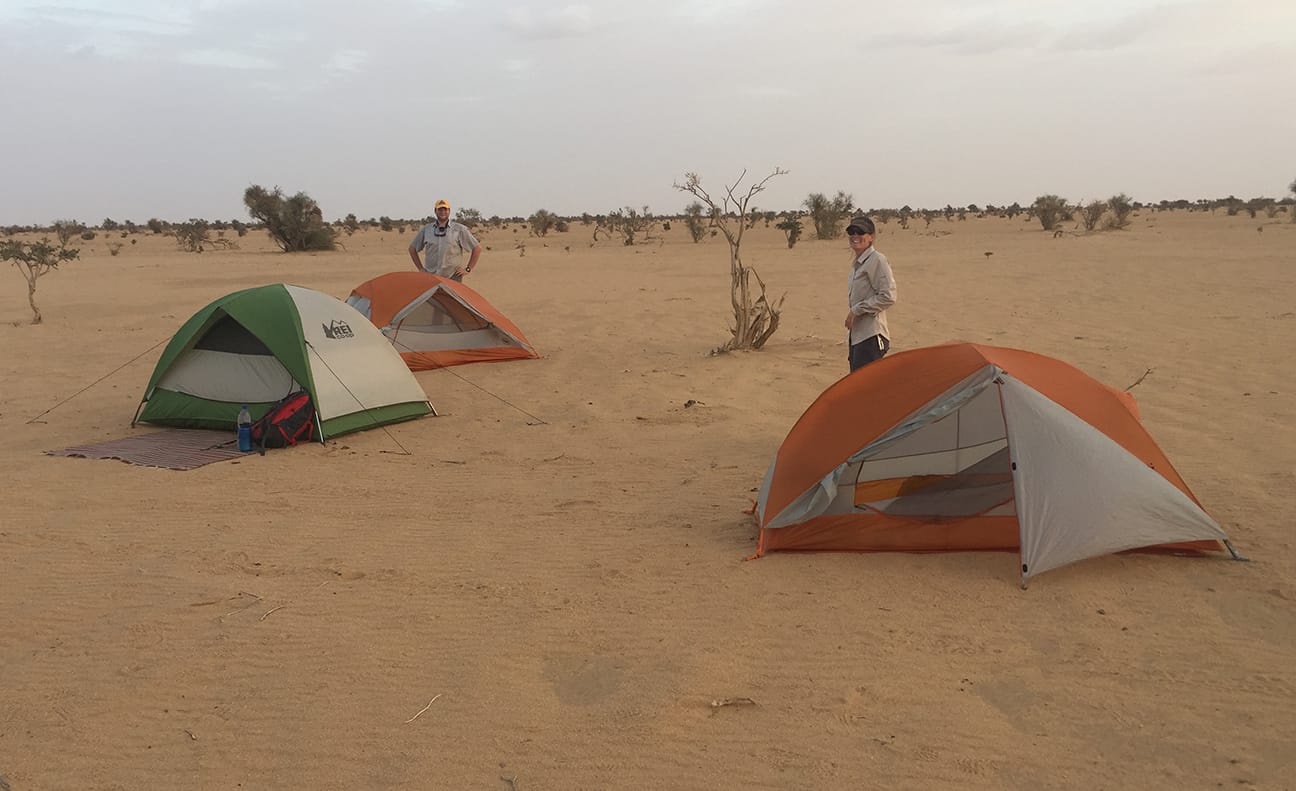
When he was coming out here in the 1970s, it was not uncommon to see 1000-plus animals including 50 SHO and 25 or more addax, plus dorcas and dama gazelle, and ostriches all in the wadi. Now, most of that is all gone. It is incredibly sad to see what has been ruined by overpopulation, civil war, and desertification.
As a side note, John told us another story about 120-meter deep wells wherein people use camels to bring up huge buckets of water. When the bucket or rope breaks, they send little kinds down the well on a rope to get the bucket!
It turned out to be a beautiful night of camping in the desert.
Tuesday, 7/17/18, Day 9: Nothing Beats An African Sunrise
Desert camping in between the wadis was pretty darn awesome. Waking up to the desert sunrise was not a bad way to start the day. We had a quick breakfast prepared by the SVS crew, and then all headed out to check the camera traps that Tim set last night.



The camera he put by the old aardvark den had a few good pictures of a Rüppell’s fox. The other trap, which we baited with the skin of yesterday’s sheep we had for lunch, didn’t yield any striped hyena pics like we were hoping; it was a bust.
In total, our vehicle convoy has traveled about 150 miles into the desert on this excursion.
The drive back to camp was extremely hot today, way hotter than yesterday, and a bit on the slow side. The birders of the group stopped about every five minutes to look at birds and turned these into 30-minute stops. One cool find of the day though, were fairly fresh aardvark and warthog tracks at the Wadi Karma.
Today, I rode back in the truck with John and Adam, while the Moroccans went with Tim. I was able to learn a lot about the history of SCF and Sahelo-Saharan Interest Group, as well as how John got his start in Chad some 40 years ago. He started out working as a wildlife biologist for the UN Volunteers program in Chad.
Then, he spent 20 years working for World Wildlife Fund (WWF) in Chad and Niger. Eventually, he was promoted to the head of African conservation for WWF and moved to Switzerland, continuing that job for 12 years. After transitioning away from WWF, he went to work on a project with the Environment Agency – Abu Dhabi (EAD) and moved to Abu Dhabi for three years.
It was the relationships he built there that eventually led to the EAD’s involvement with the SHO project. Overall, the rest of the drive back was enjoyable, and it was fascinating to hear Newby’s stories.
We had a nice dinner at camp and everyone got the desert grunge showered off of them – well as much as possible out here.
While we were all hanging out after dinner, Adam went to the guys’ container where our gear is stored and was joined by a pretty large camel spider. This has to have been about the 20th of these massive spiders we have seen. They actually became such a presence at dinner we started to give them names: Frankie, Steve, Caroline, etc.

Adam trapped his little friend behind one of the sleeping mats and came to get a bowl to use to remove him. Ric, Justin, and I went back to the container with him to see how this would play out. With Ric filming this encounter, I used my sleeping pad as a sort of barrier, and Adam got the thing under a bowl.
Unfortunately, due to capturer error, the spider must have sustained some trauma. When we went to release him, he was clearly beyond repair, so I called on my training I received from Julie on quick emergency euthanasia in the field and squashed him with my foot.
We spent the night in our tents with the rainfly off and just on our sleeping mats; there was a chance of rain so we were equipped as light as possible in case we had to retreat for the containers. It actually ended up being one of our best camping nights with a good breeze that made the heat bearable. The sleep really must have been good because I slept until 6:30 a.m., which is about 90 minutes longer than usual.
Wednesday, 7/18/18, Day 10: Disappointments And Tempered Expectations
This was the day that we were originally scheduled to be leaving camp to head back to N’Djamena. A few people who didn’t extend their trip left this morning. Yasmina, the social media coordinator for SCF, Zouhair and Latifa from Morocco, and Mark the SCF manager in Chad all headed out.
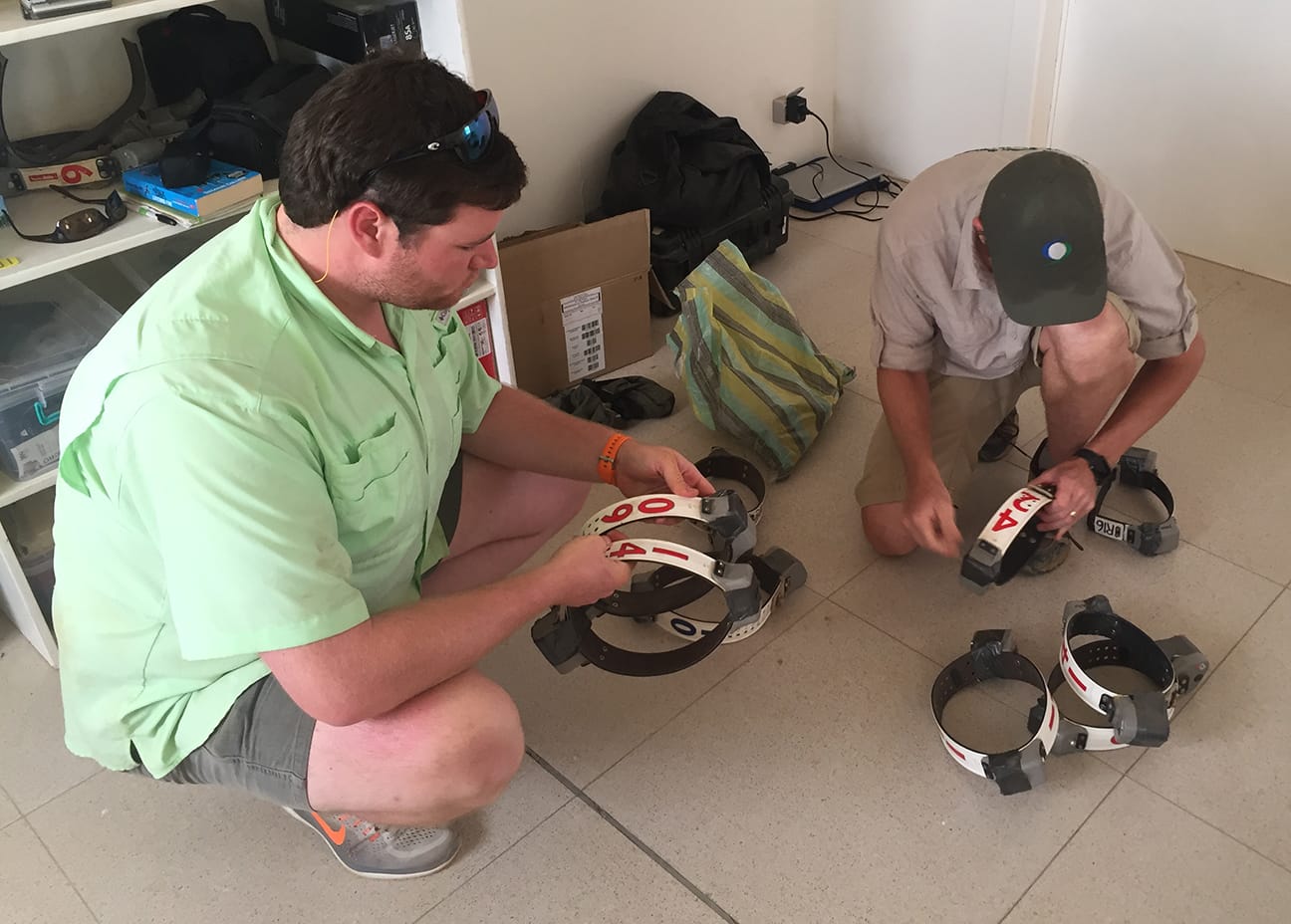
I finally got to go down to the oryx holding and working pens this morning and do a little bit of work. Even though it was only for an hour, it felt good to have something productive to do instead of sitting and waiting for GPS collars to arrive. Ric, Justin, Adam, Julie, and I worked on sanding down all the wood inside the TAMER Jr. – a lightweight drop floor chute – that we will be using to handle the oryx.
Even though the wood is only two years old, the unforgiving desert environment is wreaking havoc on it and the laminate is pulling away. We sanded off all the rough spots that could rub or scratch the animals when they come through the TAMER. The physical labor was nice and it really wasn’t too hot, all things considered.
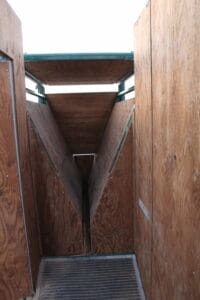
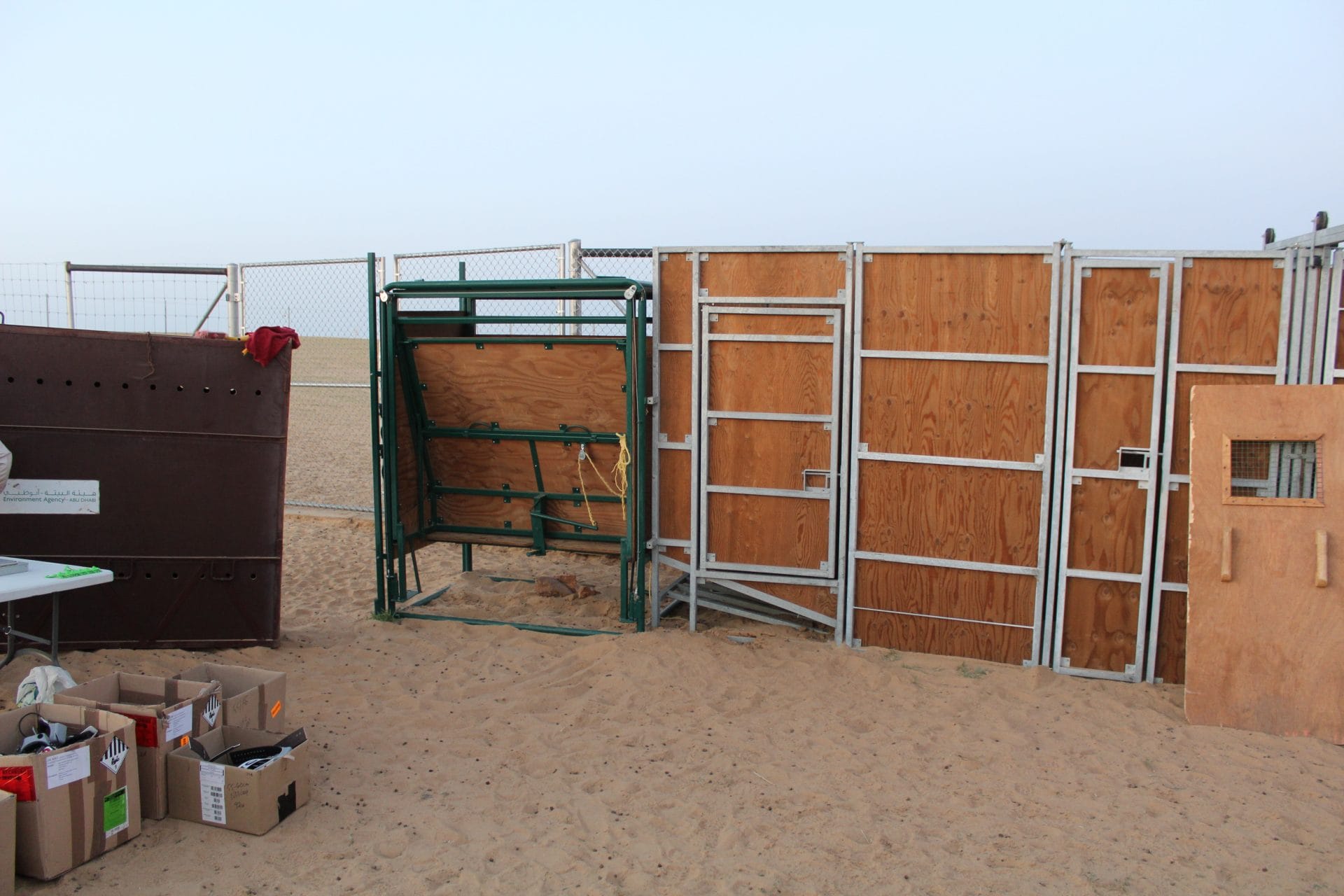
Around noon, we were all sitting in the office container, taking a break in the air conditioning, when Newby got a text that the collars still had not left the Paris airport. Katherine has been Skyping with the transport company trying to resolve the issue, but who knows what will come of that. Keep in mind, the collars were supposed to be in N’Djamena last night and clear customs this morning.
Supposedly, the collars could arrive tomorrow (Thursday), clear customs by noon on Friday and be here midday Saturday after the drive out. If this really happened, we would have to work very hard Sunday morning and night to avoid the midday heat and get all 80 animals collared before we leave for Abéché to catch our United Nations Humanitarian Air Service (UNHAS) flight to N’Djamena at 7 a.m. on Monday morning.
It looks like there is a real possibility, a strong one in fact, that we won’t accomplish the mission for the trip. We discussed a possible backup plan of some people coming back in October for just a week to do the collaring, but let’s hope it does not come to that.
At 2:47 p.m., a big sandstorm rolled into camp and we all stood out by the wind turbine to watch it come in. It is an impressive sight to behold. We went inside the guys’ container for cover, as the winds howled and sandblasted camp for a good 15 minutes.

I stuck my iPhone out of the door crack and got a decent little video of the blowing sand. Then it rained and cleaned most of the sand off. One bummer is that Adam left his laptop charging in the office by the door, and sand came under the door and covered his computer.
Thursday, 7/19/18, Day 11: Expedition Dama
Today, we went to go find wild dama gazelle, which is no easy task considering there are only about 100 left in the wild, so it is like finding a needle in a haystack. In the reserve, it is a relative stronghold for them with about 20-30 remaining. I was in Newby’s truck with Adam, Julie, and Thomas (Newby’s grandson).
We headed out of base camp at 6:30 a.m. and drove west into the typical dama territory. But the area was full of camels, cows, and nomads, so there were no dama to be found. So, we headed farther north to try to find them.
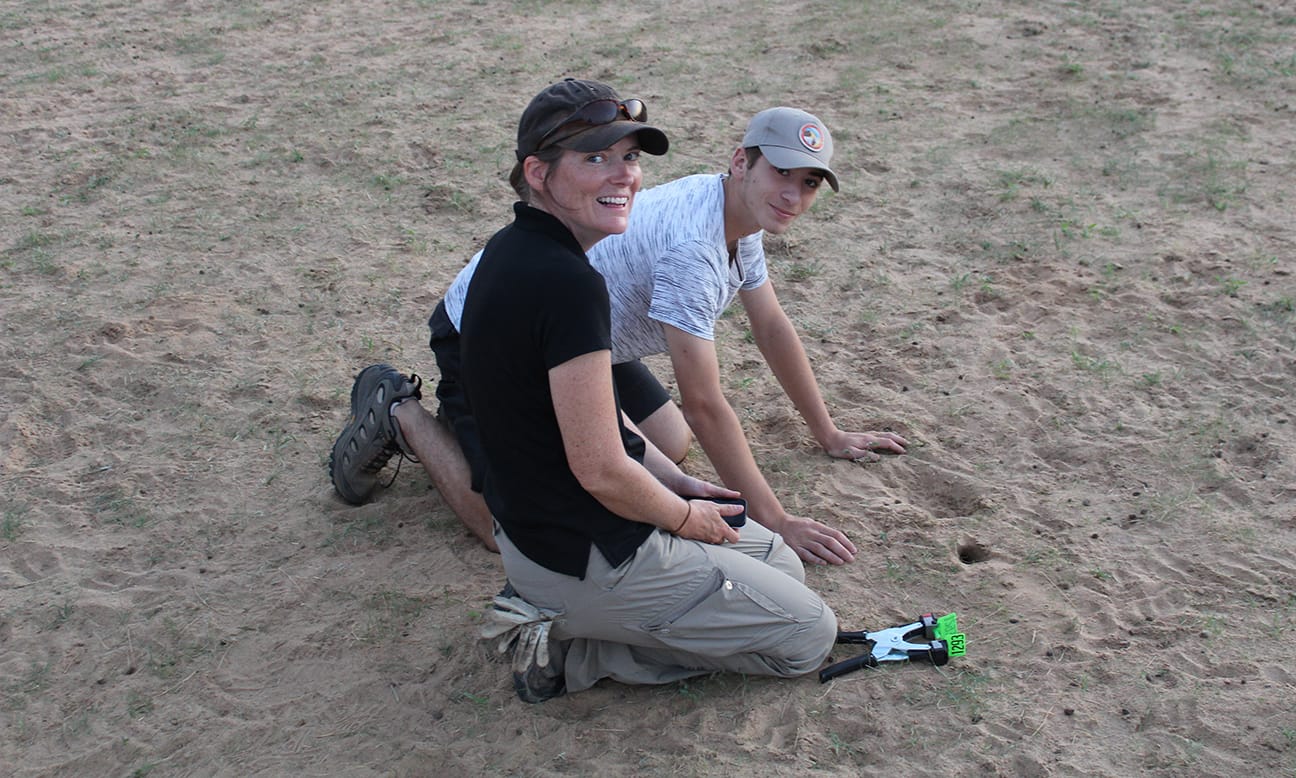
At 7:50 a.m., we spotted one male, which accounts for one percent of the wild population. He was located about 30 kilometers northwest of basecamp; he was extremely far away though, and we could barely see him with our binoculars. But it was so exciting to see him and humbling to think that we are some of the only people in the world that will see wild dama gazelle this year.
In another area at 8:55 a.m., we spotted a female dama and then saw a beautiful dark-colored male at 9:23 a.m. On this expedition we saw three percent of the wild dama population, and possibly four percent, as I think there was one more that went behind a dune.
They were all extremely flighty, only in binocular view and impossible to photograph. What is concerning is the fact that all of them were alone, and not in social groups, which does not bode well for their long-term survival unless we supplement the population with more animals.
After the dama search, we turned our attention to tracking SHO signals. At 10:45 a.m., we spotted a herd of 13 animals under a tree near a shallow watering hole. The herd consisted of four males, six females and three calves, with the calves being April births.
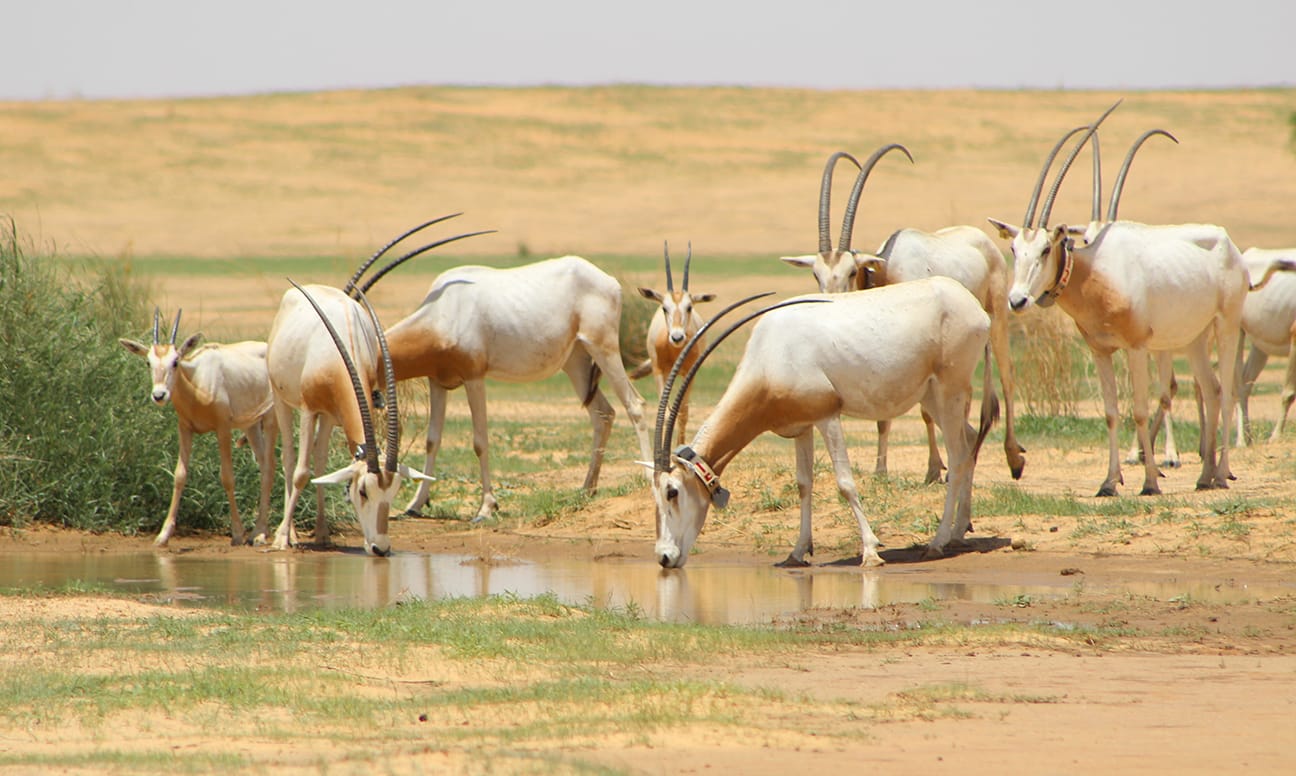
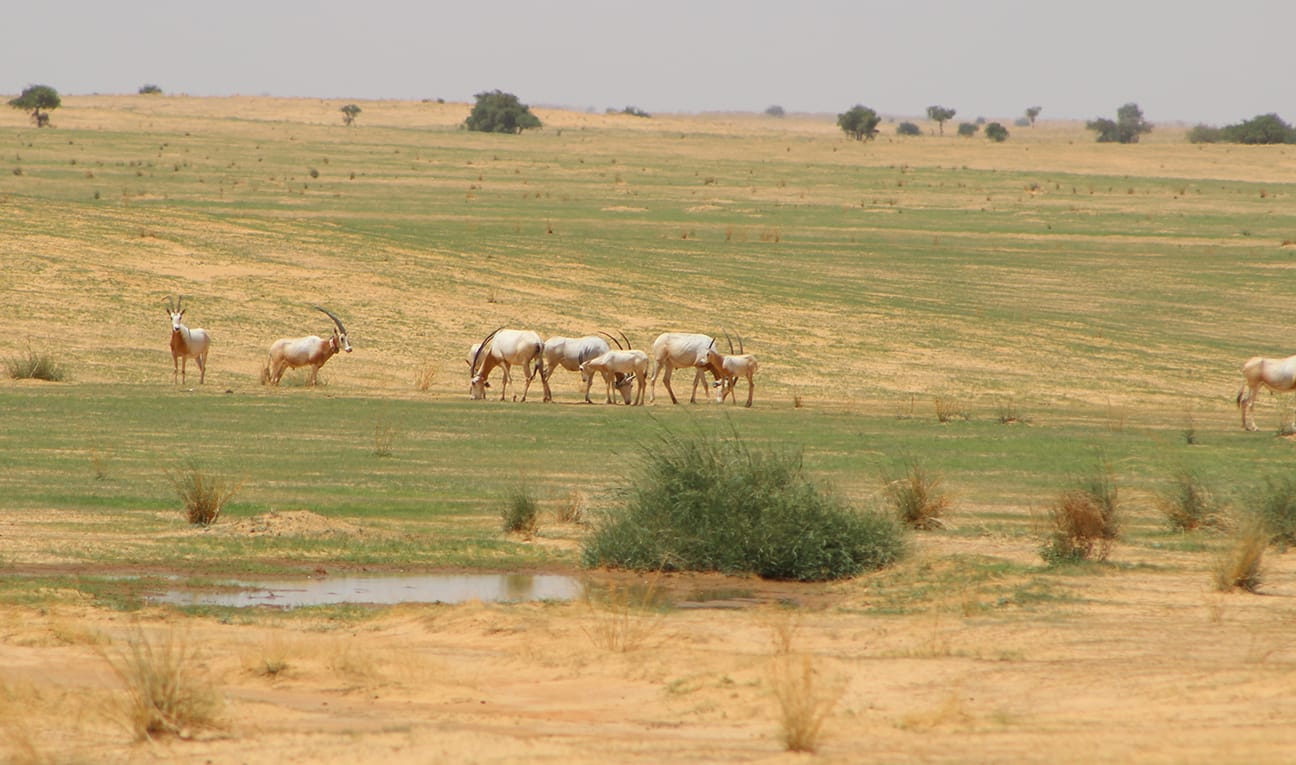
One of the cows had a very big udder and looked like an excellent milker. We even got a chance to see one of the wild-born calves nursing, which was very neat. The most exciting part of this encounter was that we saw the entire herd come up to drink, which Newby says is really the pinnacle of desert oryx spotting. I got a few good pics, too!
At 11:42 a.m., we found a small herd of six SHO, including one male, three females and two calves. The cow without a calf, R03, looked pregnant to me and I think she will calve in the next 3-4 months.
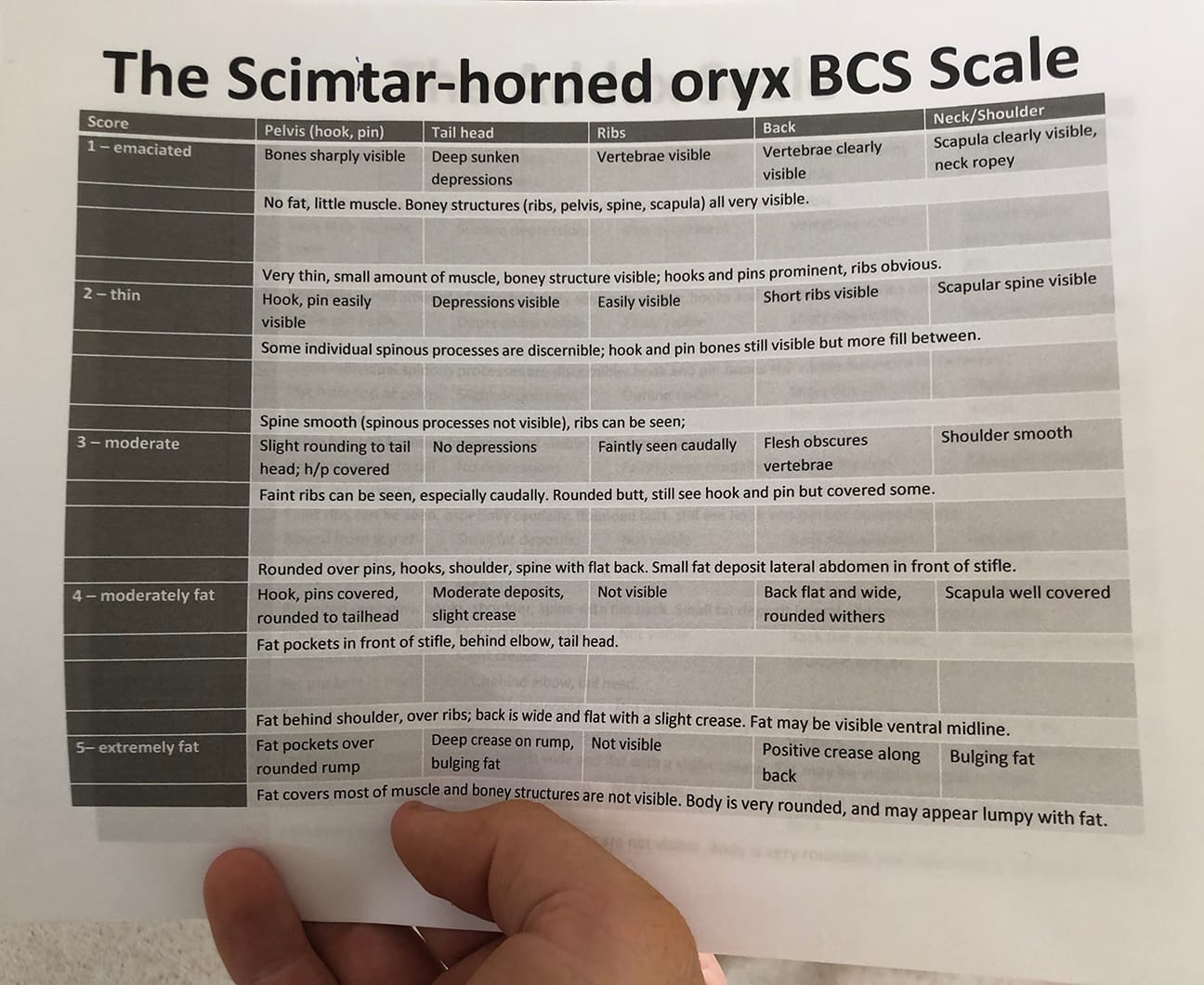
Nearby, we spotted a single SHO bull, Red 45. He was away from his normal location – northwest of basecamp. We did a quick body condition scoring (BCS) field assessment and estimated him to be a five, the ideal score (on a nine-point scale).
Then, we found another single bull, blue 23, that did not look very good. We did a BCS evaluation on him. Adam says that Fossil Rim animals with a score of 4-6 he considers to be in a good range with no intervention required.
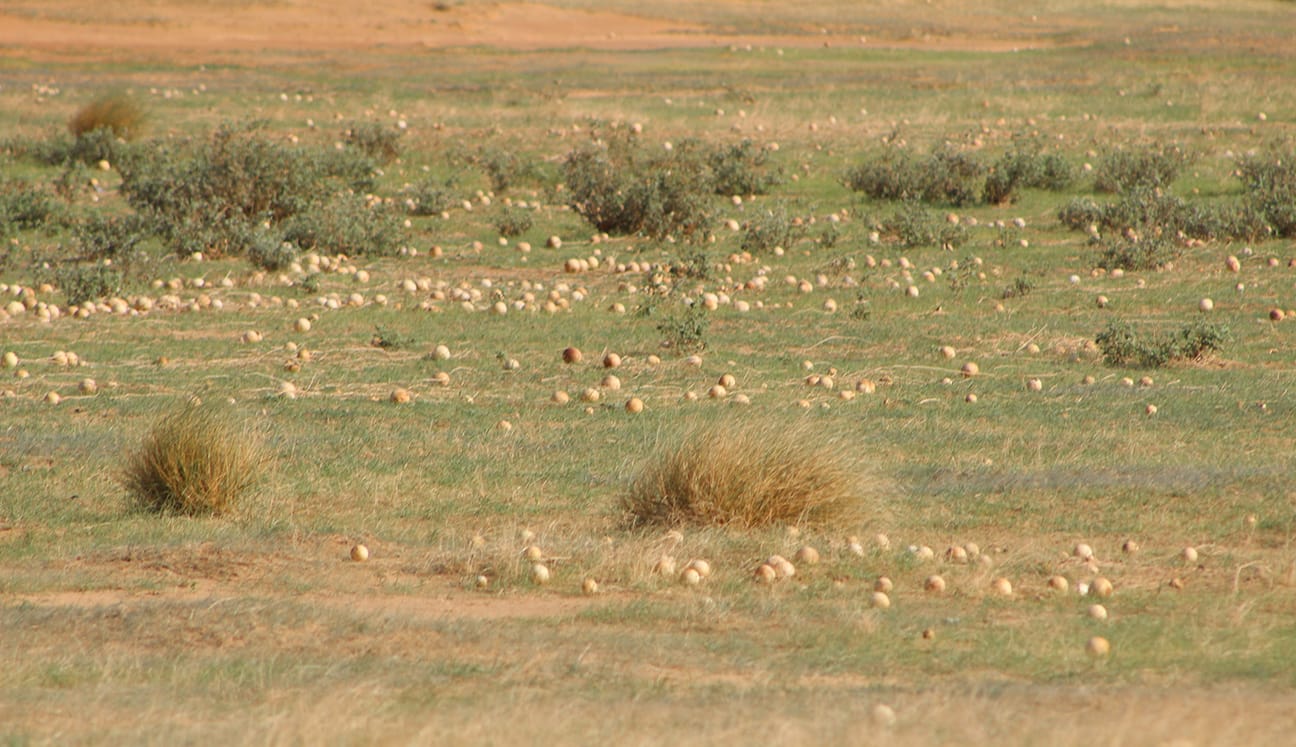
I scored this bull at a three, because he was more than one step down from the ideal score of a five, and if he was under my care he would fall in the intervention threshold, so he must be lower than a four, in my opinion. Adam said he was a low four, and Julie seemed to agree with me that he was a high three. Now keep in mind, low/high are not actual things in doing a BCS evaluation.
After that, we came back to camp for lunch and rest. At about 4:30 p.m., we left for an evening game drive and didn’t see very many animals. We tried tracking an oryx bull without any luck.
We did see one pale fox, tons of camels, and a lot of nomads and their camps. It was an enjoyable drive and we were treated to a beautiful African sunset. We were hoping to see an aardvark on the way back to camp, but no dice.

Since I have been wanting to see a wild aardvark so badly, after dinner Tim took Adam, Julie, RoxAnna, and I out “aardvarking”. We were out from 8-9:30 p.m. I used my tactical flashlight to spot animals from the Land Cruiser and it was a blast, one of the best outings of the trip.
Good animal viewing and good company in the Chadian desert at night is hard to beat. We even did some light “herping” for frogs at a watering hole we found. We might not have seen any aardvarks, but we did see five jerboas, sand gerbils, African pygmy mice, a wolf spider that I spotted with its eyes shining and then we found on foot in the brush, dorcas gazelle, four SHO, three pale foxes, a frog, and an owl that Adam saw.
Friday, 7/20/18, Day 12: The Collars Have Landed In Chad!!!
The collars finally arrived in N’Djamena last night and are loading at 11 a.m. on a specially chartered flight to Abéché with Katherine and my luggage! So, it looks like our collaring plans are on. Ric and Justin are working this morning to get the oryx in the catch pens so they will be ready to work through the chute system to collar tomorrow.
We plan to collar tomorrow (Saturday) morning, evening and Sunday morning. John will be heading back to N’Djamena with two luggage vehicles as soon as we are finished on Sunday. We have to send most of the luggage back by car because our UNHAS flight on Monday limits us to 15 kilograms of luggage each.
The first part of the day around camp was slow and pretty boring. Adam, Julie, and I all took naps and read our books. I finished my book, Last Chance to See; it was excellent. Adam is still working on Catch 22, and who knows what Julie is reading on that space-age book they call a Kindle.
We were all desperate for some work to do, so at 3:30 p.m. we went down to the pens. We worked on fixing the shade cloth the oryx had torn up with their horns, plus moved some shipping crates and supplies for collaring. The guys fed the oryx, and I hauled jugs of water to their tanks – 16 five-gallon cans in all.
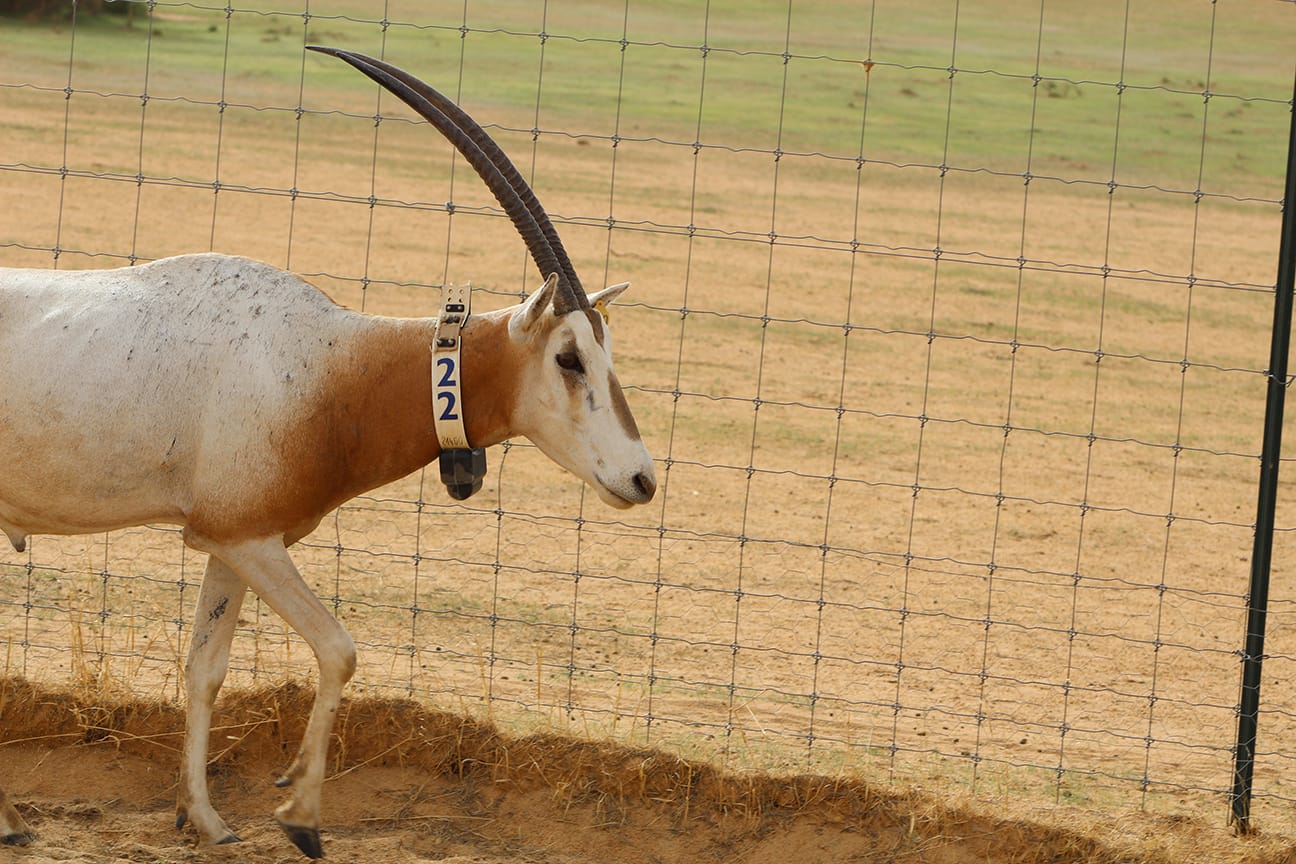
After dark, Ric and Justin were going over the paperwork and it looked like one of the oryx calves was missing from the catch pen. Our concern was that it might be bedded down in the larger pen and needed to be with its mom to nurse.
So, Justin, Ric, Adam, Julie, and I spent an hour driving with flashlights in the Mule ATV, searching every corner of the pens looking for the calf. No luck, but it turned out to be just a paperwork error and there was no missing calf. Whoops!
Katherine arrived at 8 p.m. with the collars and my bag that has my clothes in it. I will have my workpants and long-sleeve shirts for collaring so I don’t fry in the sun!
We set up a massive assembly line to get all the collars ready to use. We programmed them, removed their magnets to turn them on, measured, and checked antennas on 75-plus collars. We finished up at around 10:30 p.m. I would say that a lot of our progress was due to the tunes that Adam played, his old standby 80s playlist “Bikin’ Goodies”.

We all slept out in our tents and it was a hot night with an early wakeup call of 4:30 a.m.
Saturday, 7/21/18, Day 13: Let The Collaring Begin
We all woke up at 4:30 a.m. so we could get to the pens at first light. I’m pretty stoked that my clothes came, and I get to wear my favorite SPA hat now that it has arrived – score! A quick breakfast of protein bars and we got the gear all loaded to head to the pens.
Everything was set up and ready to go at 5:50 a.m.
Ric assigned me to be on the right side of the TAMER with Adam to put the hoses on the horns as the oryx came into the chute to prevent anyone from getting stabbed. Luckily, pretty soon Adam was nice enough to start switching off with me and I got to hold the head and horns, as well. RoxAnna and Ric were on the left side, with Ric holding horns and RoxAnna dropping the floor on the chute.
Ric is incredibly fast getting his side of the chute down and hands on the horns. But I did beat him to it once or twice. Justin was on push board duty, bringing the animals up the ramp and into the chute. Then, once they were in the TAMER, on the really wild ones, Justin would kneel on them to keep them in the chute.
The TAMER we are using is a junior size, which is borderline too small for SHO, especially big bulls. The big boys sit too high in the chute and thus have lots of leverage to thrash around and make our lives difficult. We had some really challenging animals that would flail around a lot even after we dropped the floor and would get a leg out to the side or something like that, but we managed.
The way the procedure would go when I was on the head was Justin would push them into the TAMER, RoxAnna would drop the floor and Ric and I would drop the sides to grab and secure the head and put on the blindfold. Then, Adam would put the hoses on the horns and secure the back end with RoxAnna and Justin. Julie would open the front, check the animals, cut out the old ear tag and replace it with a new one, while Tim would measure the neck so Katherine would know which collar size to use.
Katherine would fit and secure a collar, Tim would photo and measure the animal’s bite, and Julie would check the animal overall. Once given the “all clear” by the vet (Julie), horn hoses would come off, Ric would open the side to let the animal touch the ground, and then I would hold the head and remove the blindfold as they ran out. If Adam was on horns and I was on hoses, this was reversed.
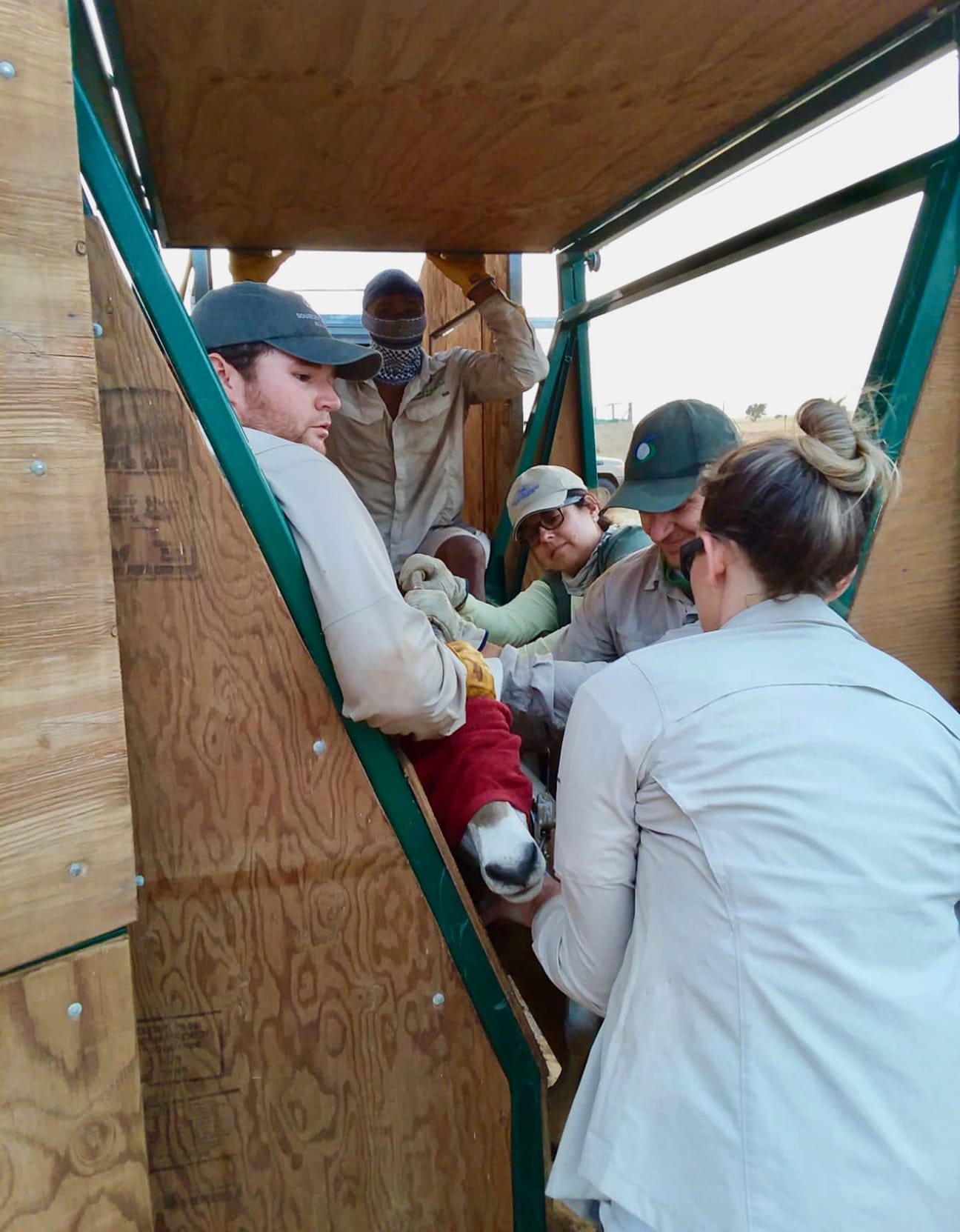
It is worth noting that Katherine was doing all this at seven months pregnant!
John Newby used his really good camera and got lots of excellent photos of the collaring operation today. Adam had his GoPro on for a while and got some cool footage.
Overall, in the first morning, we finished by 9:30 a.m. We got 25 animals run through and collared; we could have done more, but we did not have all collar sizes ready. Some were still connecting to the satellites and could not be deployed yet.
We are going to try for another group this evening and finish tomorrow morning. Inshallah (“God willing” in Arabic)!
Tonight, we also have to pack up all tents and other gear to send back with John in the morning. All we can take on our UNHAS flight is a backpack per person. My bag just got here and it is already leaving me after 36 hours of being reunited.
We were scheduled to be going back down to the pens at 4:30 p.m., but at 4 we noticed a sandstorm blowing in. So, we quickly took down our tents in basecamp and got all the miscellaneous stuff put away.
After a lot of consternation about whether or not we should go ahead and go down to the pens to start collaring regardless of the storm, we decided to push ahead. We had to go down and remove the game capture cloth anyway to prevent it from being ruined in the storm.
We did end up having a sandstorm, but it took longer to get there than we thought. It arrived while we were working an oryx in the chute, and then it rained on us, as well. Working in the desert is so glamorous.
We ended up running 13 adults through the chute and put collars on them, plus caught five calves, tagged them, and got them back with their mothers. We had one female separated from her calf, and until we could catch it, my job ended up being to keep her back from the work area so she didn’t get too close to all the people where she could really do some damage.
Most of the folks were way too cavalier about her presence, so I kept her pretty far back. That cow ended up charging me three different times; she was not out of control, but was mad!
We had one cow that refused to come into the chute, so Justin and I had to drop the sides and reach in to grab her horns and pull her in before the floor of the chute was dropped. Not ideal at all, but it was pretty fun.
We wrapped up with a nice dinner in camp. In total, we moved 39 oryx today and have around 40 to go tomorrow.
Sunday, 7/22/18, Day 14: Collar Mania Continues
Today is the second day of collaring and our last full day at basecamp. We left camp at 4:45 a.m. and had the first animal in the shoot by 5:15.
We finished all the collaring by 9:40 a.m., as we processed and collared more than 70 oryx. Five of them were calves that do not get collars, plus three that didn’t get collars because of size issues.
Most of the day, Adam and I traded pretty evenly on hoses and holding horns. Then, with 15 animals left, Ric was getting bad forearm cramps. So, Adam took his side of the chute, and I took over head holding on my side, while Ric took the horn hose role.
Overall, working the chute was awesome and I loved every minute of it. Today’s group was feistier than yesterday with some really big bulls that were challenging. We had a few notably difficult animals.
I got to help grab a couple more by the horns that would not come into the chute. The biggest challenge was a huge, broken-horned bull that was the third-to-last animal. He had only a six-inch horn stub on one side and nothing on the other; this makes them very difficult to hold onto and hard to get any leverage against.
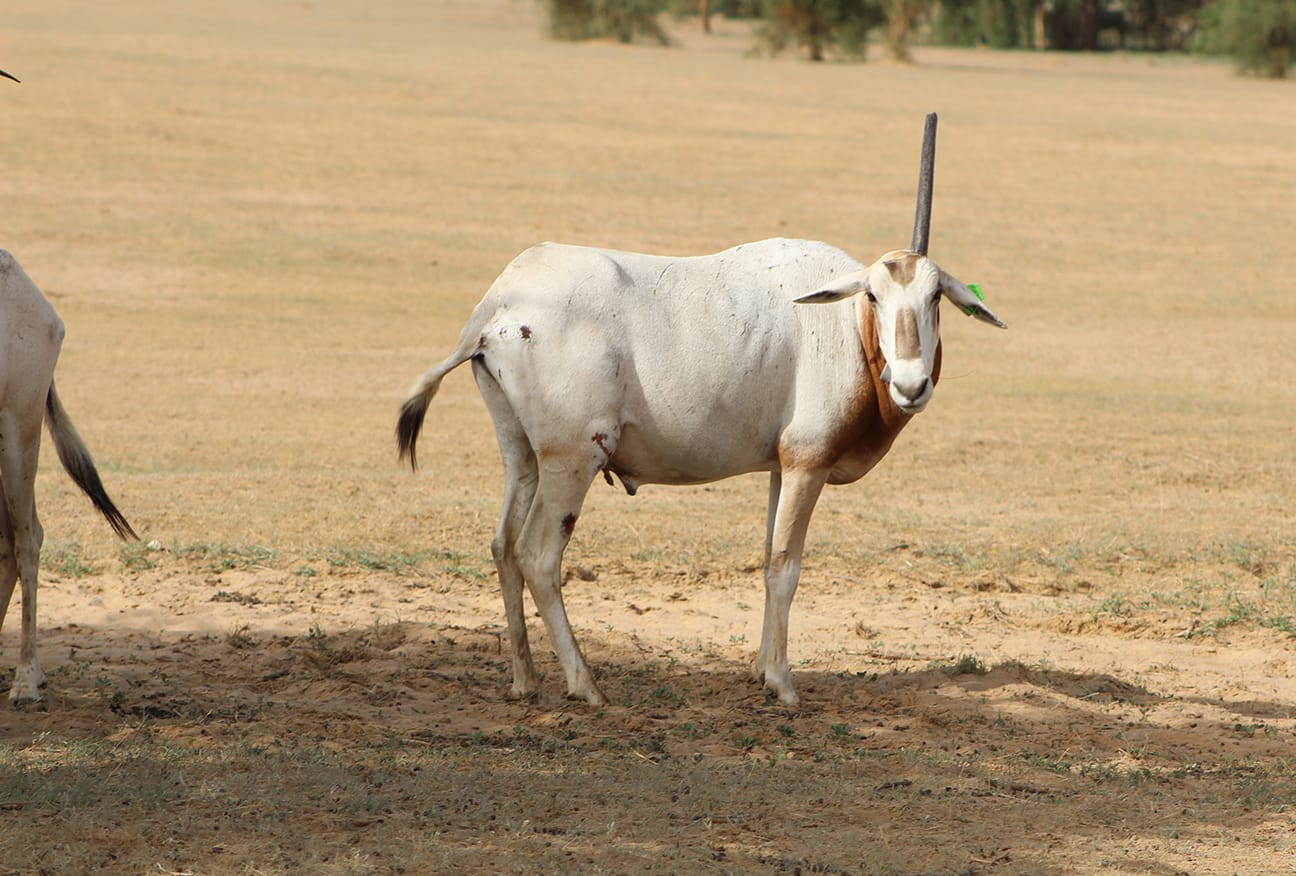
This bull was so big and long that his rear end hung off the back of the chute and his nose poked out the front. I had to take my right arm and hold him under the jaw up against the side to get any leverage at all. Then, we heard a loud cracking sound as he broke through the plywood on the side of the chute.
Ric and Justin have worked thousands of antelope through a TAMER and have never seen one break it. Our best guess is the desert weather made the wood brittle enough that he was able to just bust it with his knee.
To fix it, we used cardboard and lots of duct tape; luckily, we only had two more oryx to put in the chute. The last two animals were big, but the repair held! If this had happened the day before, we would have had a whole host of issues to deal with.
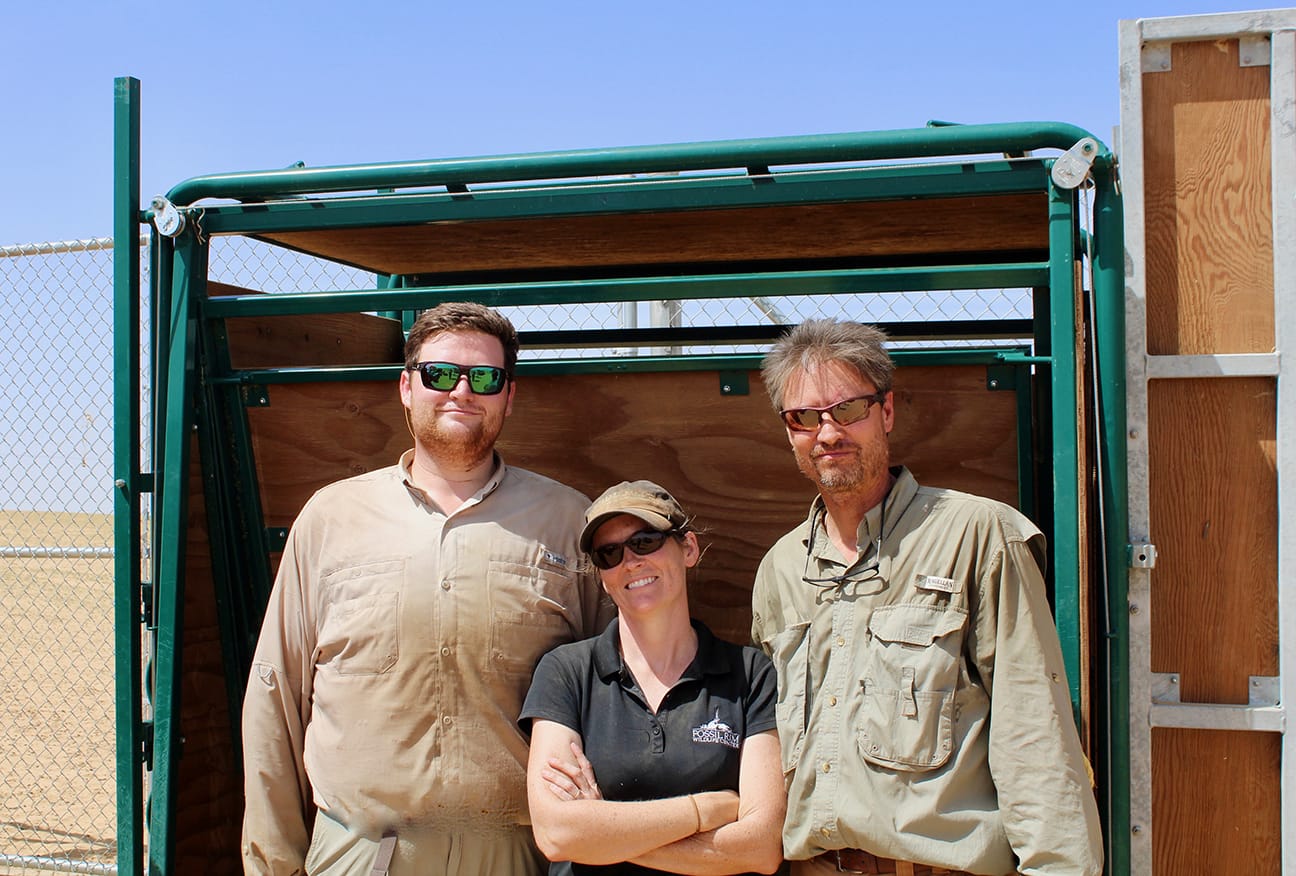
It was so exciting and a relief to be finished. We came back to camp and had a big egg breakfast made by the camp cook – it was excellent. We then got all our luggage loaded and John and Thomas were off in two trucks bound for N’Djamena.
At around 3 p.m., Katherine and I went to the pens to check all the collared animals and photo some of them. Everyone looked really good. We also managed to match up all the calves with who their mothers are and got the tag numbers and collar numbers recorded.


I got some great oryx pics in the pens, I think. As a bonus, I got some good bee-eater shots, too.
While we were at the pens, Tim, Justin, Julie, and RoxAnna went on an oryx tracking trip. They found a group of SHOs with camels and nomadic family homes scattered all around them.
Tonight, we all decided to sleep on top of one of the cargo containers for a good breeze. It was a great night up there with just our sleeping mats. Adam, Justin, Julie, RoxAnna, and I were all up there. The stargazing was insane, and the sunrise at 5 a.m. was no slouch, either.

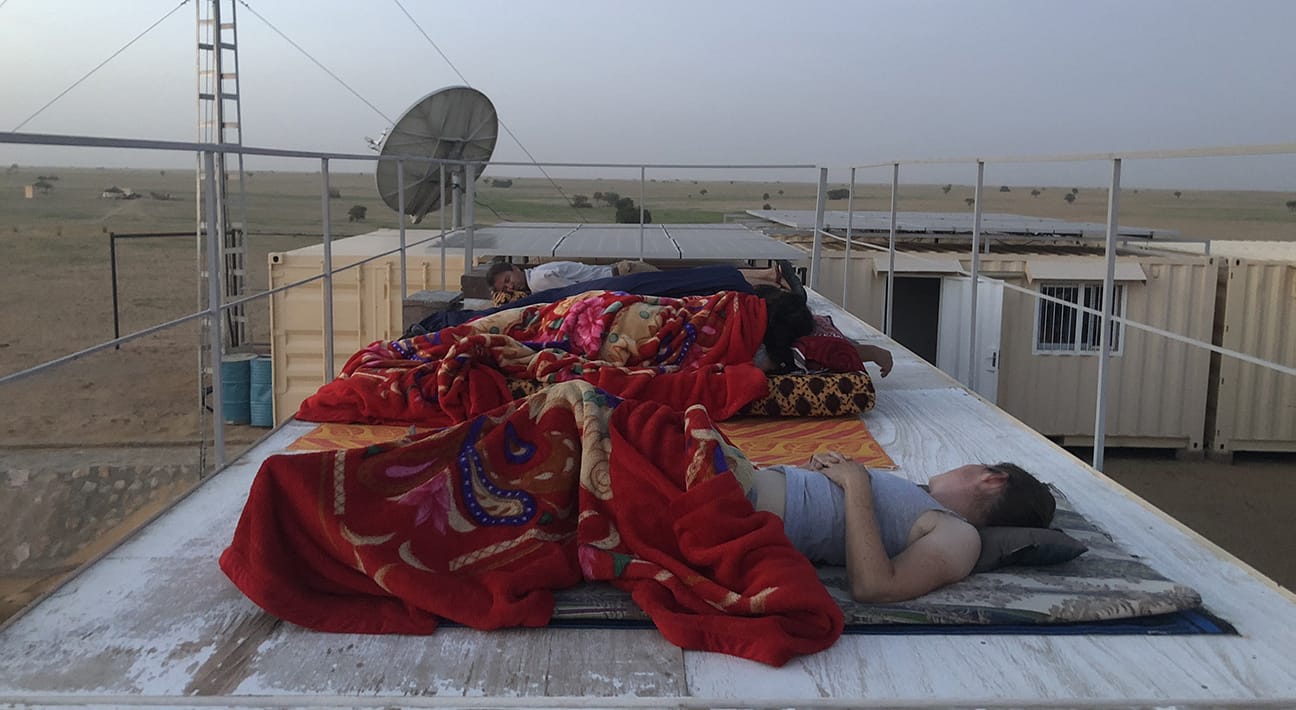
Note: There is an important part of this trip that has been left out of my journal so far, and that is the power of the wink. Adam credits his winking abilities to a lot of our travel successes on the trip. He used his winking skills to get an exit row seat on the flight from Paris, used it to try to fix our baggage woes, and secured some extra treats from the flight crew. Now, since we had a less-than-ideal travel experience, his winking abilities might be in need of a refresh.
Monday, 7/23/18, Day 15: Journey To Abéché And N’Djamena
The journey back to Texas begins today. We left basecamp for Abéché at 9 a.m. We took the EAD V8 and the monitoring truck to the airport along with drivers and an armed guard.
I rode with Adam and Justin in the monitoring truck, while the guard was in the bed. Everyone else rode in the V8.
As we drove south just about 10 kilometers from camp, it was clear this area had a lot more rain than we did, as there were lots of watering holes and grass growing everywhere. Then, that brought in the herders, while camels, cows, and sheep were coming into the area by the thousands with many camel caravans moving in while we drove past.
We got to the Abéché airport at 1 p.m. It was a two-room terminal. To check-in, all you do is show them your printed receipt and they give you a laminated yellow slip of paper that serves as your boarding pass.
About 30 people in total ended up in the very hot waiting room. When it was time for the flight, we got on a bus that drove us the 300 feet to the plane; I’m not sure why we could not have walked. The plane is for UNHAS flights.
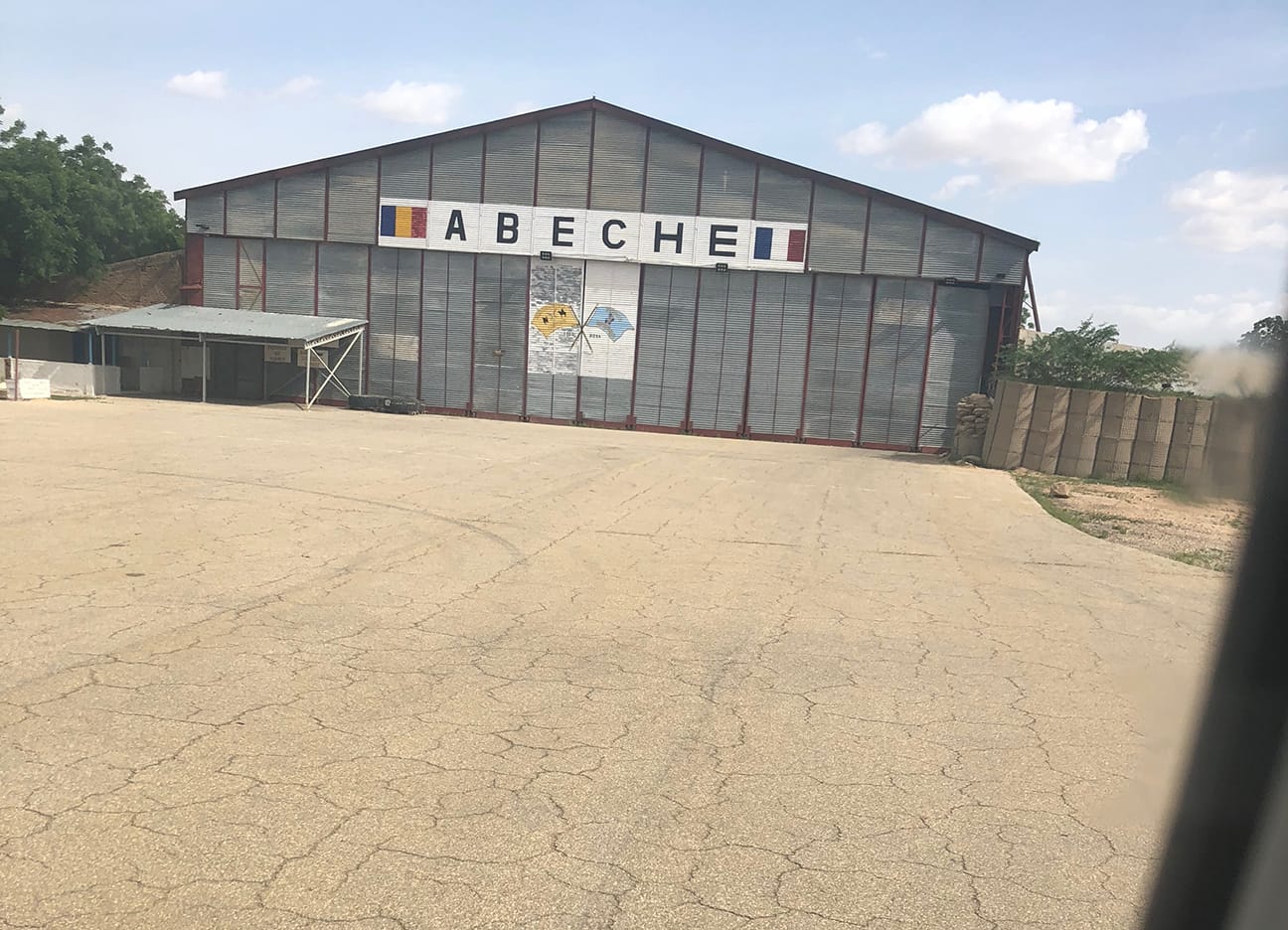
It was a regional-sized jet that holds about 40 people. Ric, Justin, Adam, and I all scored seats on the single-row side! Service was impressively good on the flight and they gave us mango juice, water, peanuts, and cookies.

You wouldn’t get that on an hour-long flight in the U.S. The interesting thing about the flight was how many airlines were involved. It was an UNHAS flight operated by Air Cameroon with food service provided by Air Kenya.
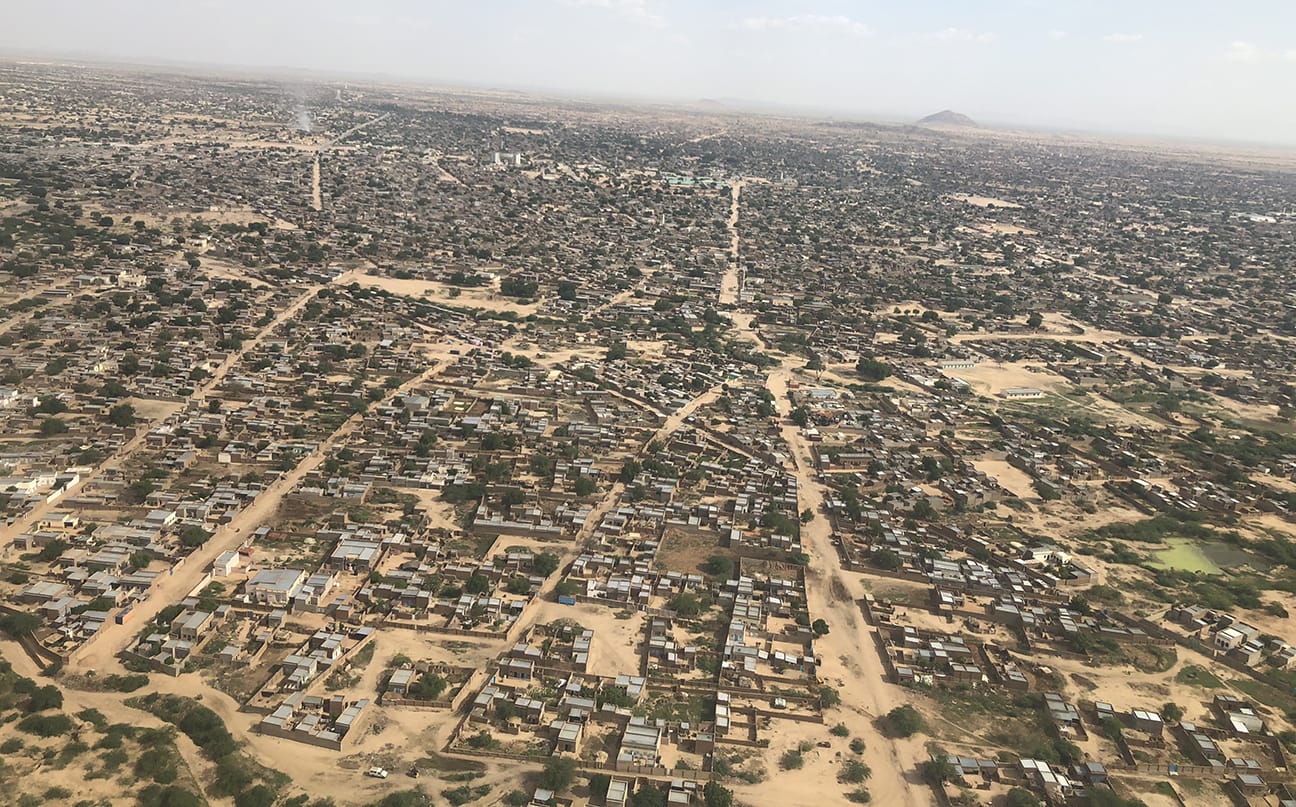
The N’Djamena airport seemed a lot nicer during the day, as opposed to our night arrival. We took the Hilton shuttle back to our home away from home, the Hilton N’Djamena. We took cold showers, which were awesome, and then had a nice group dinner.
Tuesday, 7/24/18, Day 16: Chad Gets The Last Laugh
It sure was nice to sleep in a real bed with real pillows again! Adam and I got up around 5 a.m. and went down to meet John and Thomas for breakfast (the women slept in). We had a good chat with John about SCF and the future of conservation in the broader sense. The rest of the group trickled in as the morning went on, and we all stayed in the breakfast room until 9 a.m.
At 11:30, RoxAnna, Julie, Lahaj from the EAD, Ric, Thomas, and I went back to the artisan co-op since some of them hadn’t been yet. I bought a few more trinkets for gifts to give the folks back home. I think RoxAnna pretty much closed them down, as she bought just about everything in sight.

We checked out of the hotel at 6 p.m. on late checkout, then stayed for dinner in the hotel bar until 8:30 when our airport shuttle left. Our flight for Paris leaves at 11 p.m.
To get in the terminal, all baggage must be screened before ticketing. RoxAnna and I went through last and they asked to search our luggage.
The security guy spoke very little English, but from what we gathered, he wanted us to have a special permit or he was going to take our souvenirs. Luckily, John Newby was within shouting distance and we called him over for an assist.
After John talked with the security guy, they let us through with our stuff. Passport control was uneventful, but during the security check to get to our gate, RoxAnna and I were searched again, and this time they took our coffee mugs that SCF had monogrammed with our names and given to us as a gift, plus Julie’s was taken, as well.
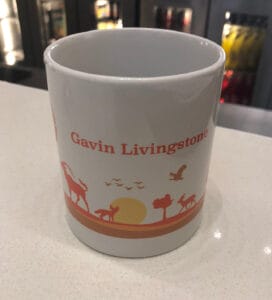
On this one, we called in a Newby assist again, but to no avail. The security guy insisted that the mugs could be broken, then used as a weapon, so they had to be left behind.
Overall, we went through 15 sets of security and passport checks. To board the plane, we had to load onto buses outside the waiting area in the terminal. To get on the buses, it required another passport check, metal detector wand run over us, and search of our carry-on bags.
After all the security checks in the airport, it was a huge relief to get on that Air France plane and have it take off.
Wednesday, 7/25/18, Day 17: Hello Paris, Goodbye Paris, Hello Texas!
After making friends with the flight attendant, Adam and I got to move from regular seats to an empty exit row, since the plane was only about half-full. Overall, it was a good and relatively enjoyable 5.5-hour flight to Paris.
Once we made it, this is where our group went their separate ways. The EAD guys headed back to the United Arab Emirates, Newby and Thomas to Switzerland, RoxAnna to L.A., and Katherine to Washington, D.C.
Adam, Julie, and I boarded a flight to Atlanta with just a two-hour layover in Paris this time. For once, I ended up having an interesting person sitting next to me on the plane to talk to. He was a 26-year-old French Army officer who of all things was stationed in Mali and knew the area we had just left in Chad.
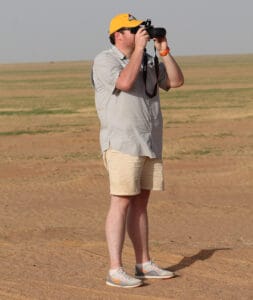
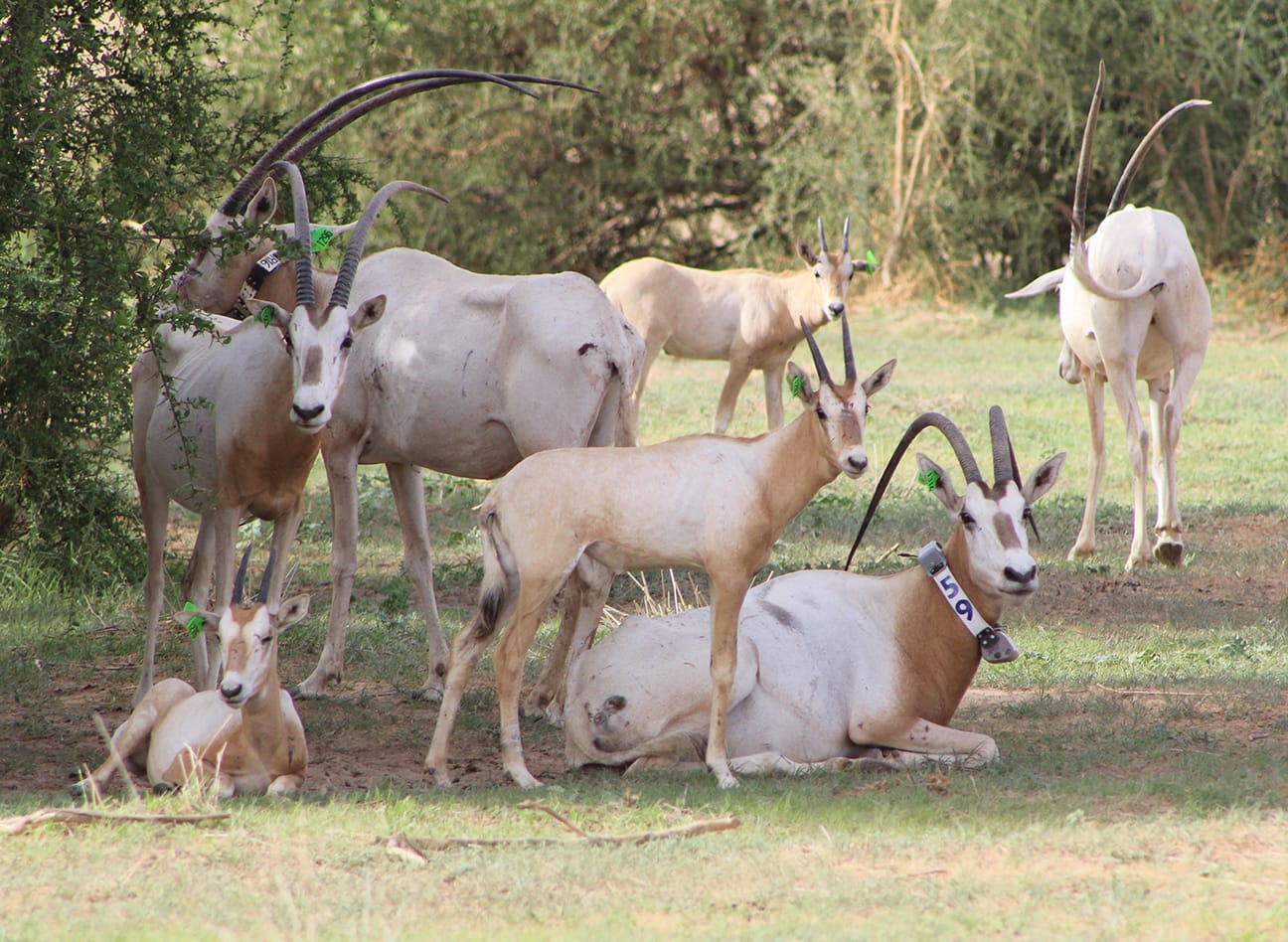
We talked all about the army, Africa, and the SCF oryx project. I showed him some of the video footage of working the oryx and pictures from the trip.
He is on his way to Nicaragua on a surfing vacation for two weeks. His English was fortunately much better than my French, but this interaction just solidified the notion that I have to improve my French skills before I go back to Chad next time.
Wednesday, 7/25/18, Day 17 (Part 2): 63 Hours And 4 Planes Later…
We made it through customs in Atlanta with just enough time to exchange our euros back to USD. The last flight on the trip saw me stuck in a middle seat thanks to all our plane changes. My winker scored himself a middle seat, but it was in an exit row. Julie drew the short straw and was next to me by the window.
When we got to DFW, and Julie, Adam, and I collected our luggage (which all arrived!). We went to the Delta baggage office to talk to them about all our problems including lost bags, broken items, and damaged luggage.
We were basically told they can’t help us since we left more than seven days ago and should have reported it sooner. I don’t think they understand that we were in the middle of the desert and there were not a lot of cell phones handy to give Delta a call about our luggage issues.
Since we landed in the middle of rush-hour traffic, we made our long-anticipated stop at In-N-Out Burger that we had been planning for many, many days. We made it back to good ol’ Glen Rose by 7 p.m., as Adam and Julie dropped me off at my place before heading home themselves.
We calculated our travel time. Since we left Basecamp Oryx on Monday, it has taken 63 hours, four planes, two buses, airport trains, and two trucks to get us back to DFW. It was an absolutely amazing trip, but I sure am glad to be home!

Gavin~. I am looking forward to reading your journal as it is posted. What an awesome experience for you and your team.
Charlotte
Gavin, you really have experience, I love your job.
Hi Gavin, wonderful to read!
I know the SCF mob from Niger and went with them to Termit in 2011 to see if Termite would qualify as an Important Bird Area. It certainly does! We also saw four Dama Gazelles close-up, awesome. If you or your colleagues have any bird observations (and pictures) from Chad in addition to those by Tim Wacher, we would be very happy to have them for the on-line, open-access, bilingual (English and French) West African Bird DataBase at http://www.wabdab.org. The WABDaB is run by Ulf Liedén, Tim and myself and covers Chad, Niger and Burkina Faso. Many of those records are from the thousands of wonderful wetlands in those countries like Wadi Karma.
Best of luck with the continuation of this project, Joost
Joost Brouwer, The Netherlands, former agro-ecologist at ICRISAT, Niger